A trilogy about images, assertions and meanings
Three series of images created between 2023 and 2025 form the basis of this trilogy. Each book follows its own aesthetic logic, but together they explore what images can (still) claim today – and what they conceal.
The title Erzähl mir nix (Tell me nothing) is both a rebuttal and a self-questioning: it is directed against the overwhelming power of narratives in the media, art and politics – and critically reflects on our own narrative practice. In an age in which images no longer prove but suggest, narrative becomes a strategy, not a search for truth.
The three volumes – Calimed image, Temporary reality, Lost truth – diagnose a present in which evidence has become fragile, reality unstable and truth replaceable. In this trilogy, images and texts are not in an explanatory relationship, but in productive tension: they contradict, complement and question each other.
The artistic and textual production consciously utilises artificial intelligence – not to increase efficiency, but to create friction. The texts are created as montages, as curated dialogues with machine suggestions and own thoughts, comparable to the collage-like construction of images.
Erzähl mir nix sees itself as an artistic-theoretical project in the field of tension between abstraction and representation, reflection and resistance. It asks what criticism can achieve today – and whether art remains a place where truth can at least still be asserted.
Volume I - Claimed Image
On the power of images – and the power of doubt
Images assert themselves. They convince through visual presence without providing evidence – and have long since shaped our perception of reality. Calimed image examines this visual dominance: How do artistic images differ from those used in advertising, politics or self-promotion? And: Are there still any images today that not only assert something, but also pose critical questions?
The volume links visual theory with a second level of reflection: the relationship between contemporary art and new music. Both work with abstract forms that are often difficult to access. But how comprehensible are these languages today – and for whom? At the centre of the book is a fictitious dialogue between a composer and an artist. In five chapters – in five specific locations – they explore image, sound, society and criticism in a tentative, argumentative and thoughtful way.
Each chapter follows a "gesture": an attitude between doubt, agreement, nervousness and resistance. The visual design does not follow any illustrative logic.
The works in the first four chapters are digital collages that are realised in three different sizes: as a wall piece (120×120cm, non-woven print for direct application like wallpaper), as a Plexiglas piece (80×80cm, digital print behind acrylic glass) and as a paper print (40×40cm). The pictures in chapter 5 are formally independent: Here, a geometric background is printed on paper, onto which three pictorial elements are applied to support materials of different thicknesses and arranged like puzzle pieces.
Calimed image is not a textbook, but a space for thought. An invitation to participate and disagree.
Chapter One: Shrugging your shoulders, indifferent
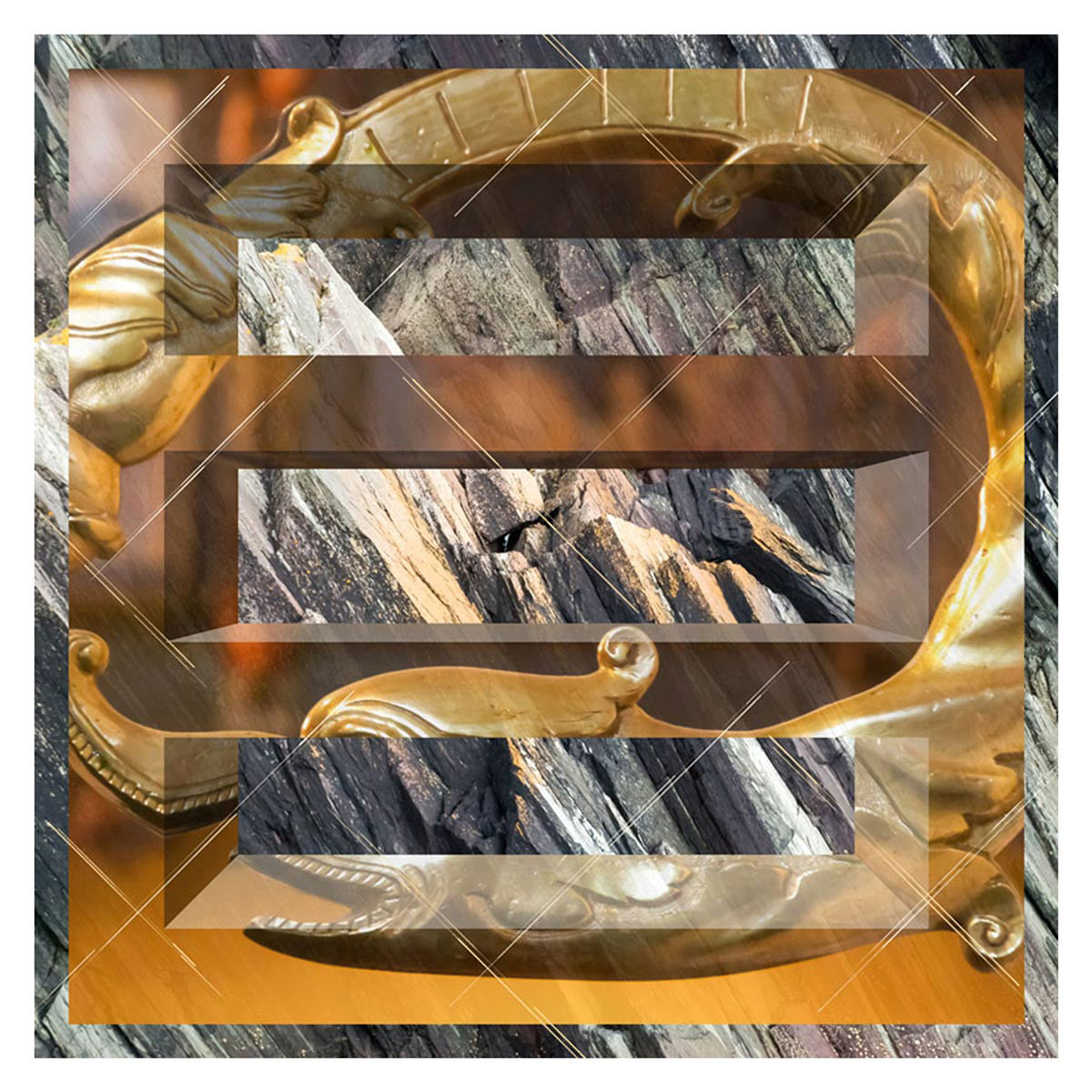
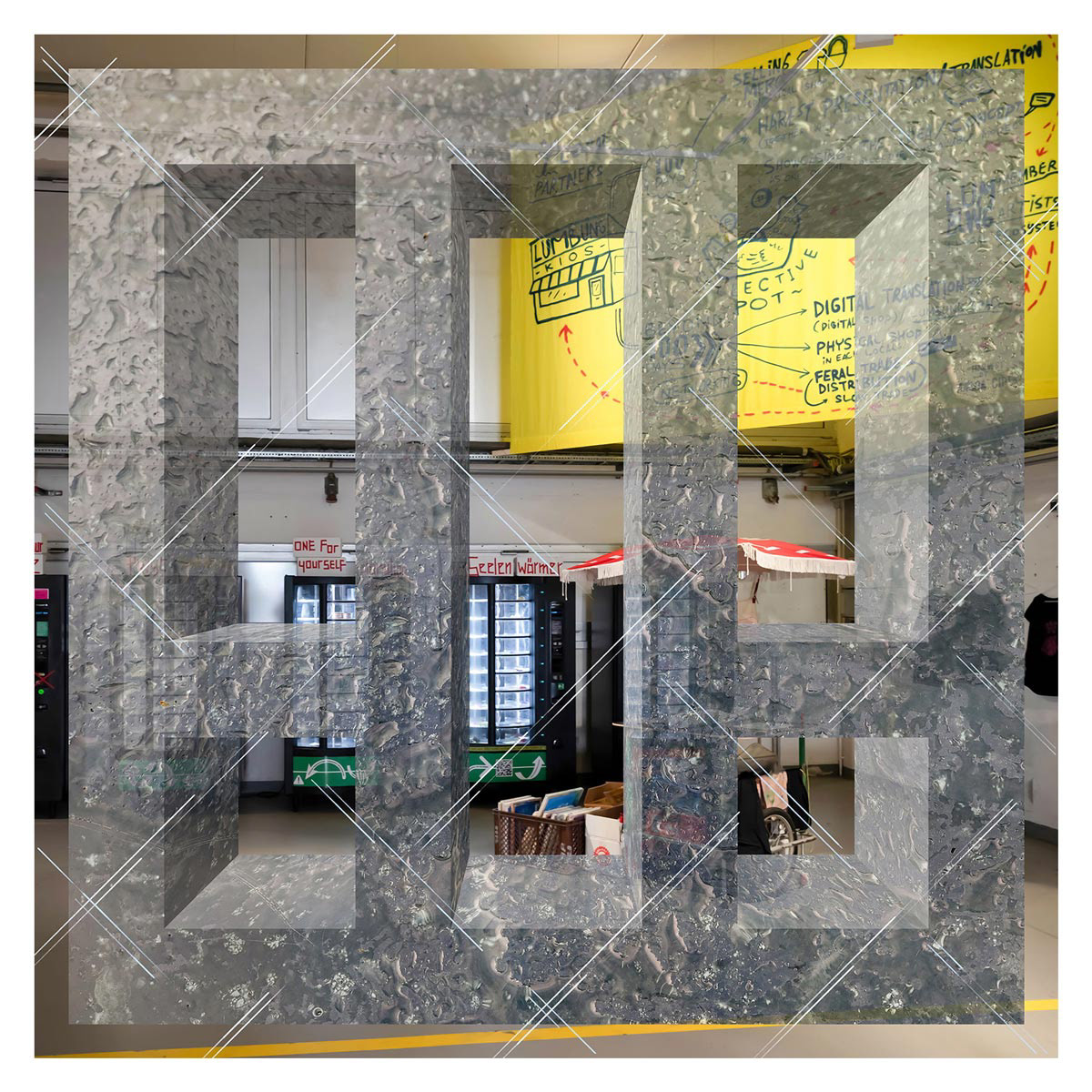
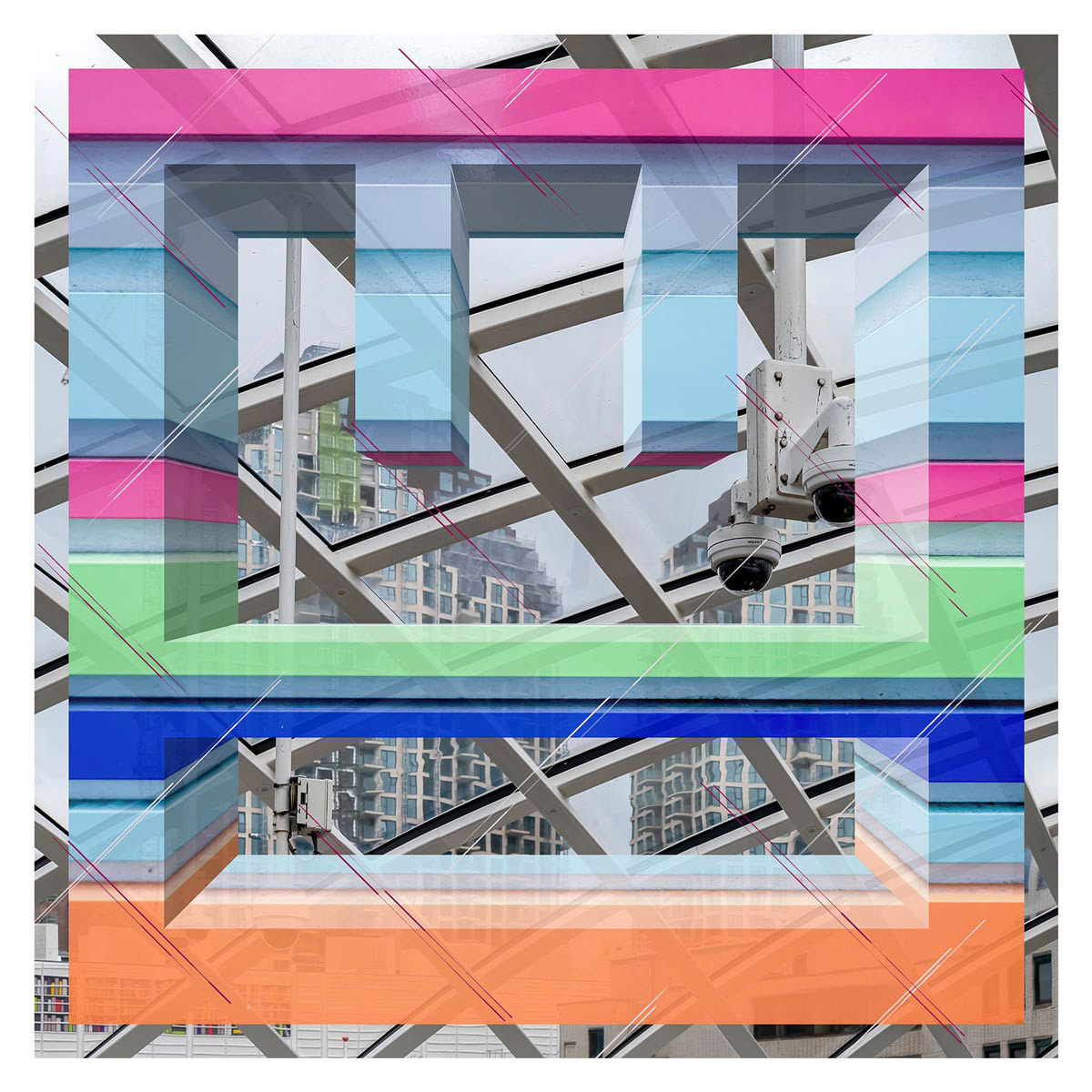
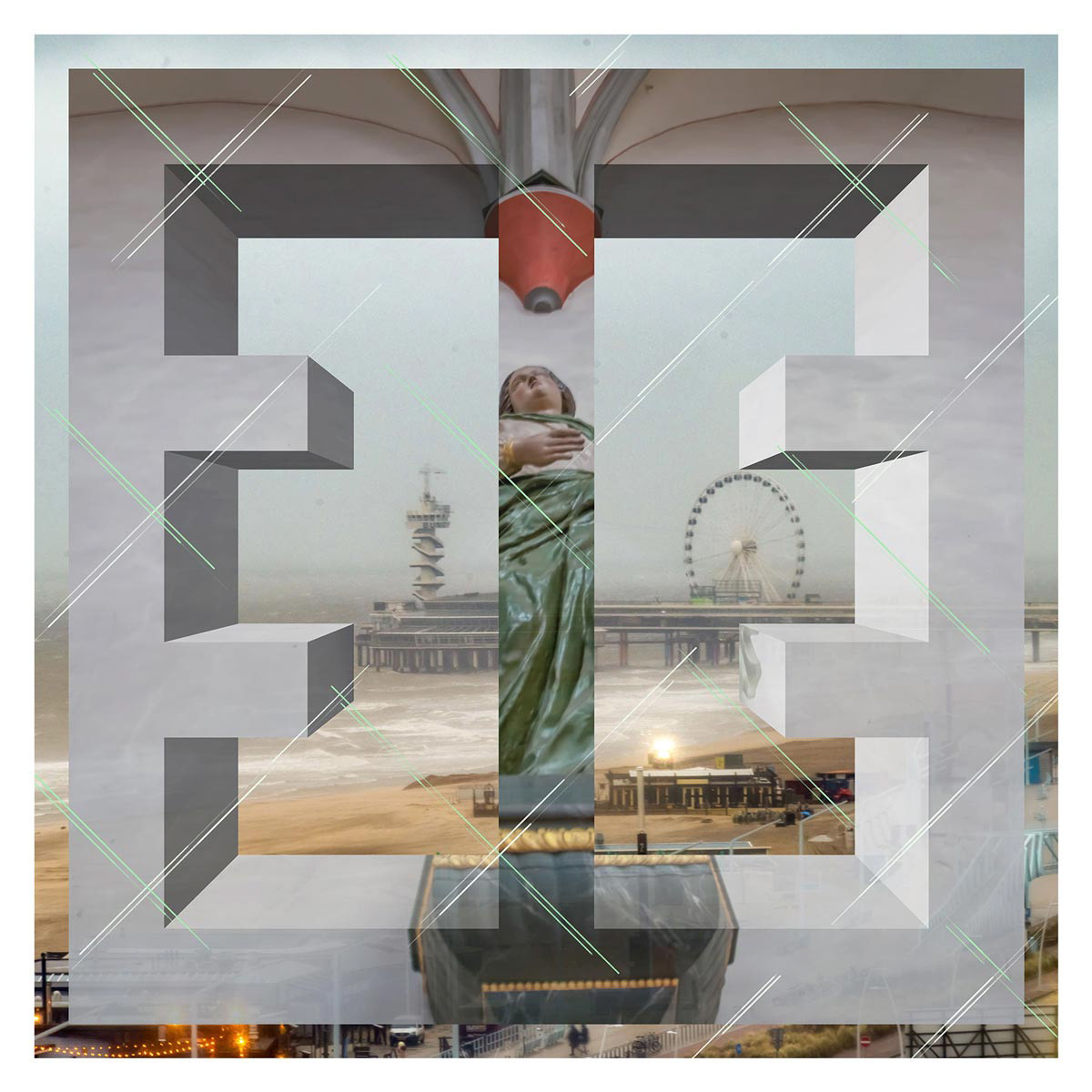
The chapter comprises 16 digital collages in which three-dimensional forms are superimposed on photographic motifs. The digital interventions disrupt the spatial logic, set surfaces against depth and shadow graphic resistances. The images are not directly related to the text – they form their own field of tension.
The accompanying text is set in various locations in Rotterdam. In an otten conversation, a composer and an artist reflect on narratives, visual logic and the pressure of meaning – and on whether indifference can be a form of critical attitude.
The complete image and text version can be found in the book Calimed image, available in the shop.
Chapter Two: Rolling your eyes, bored
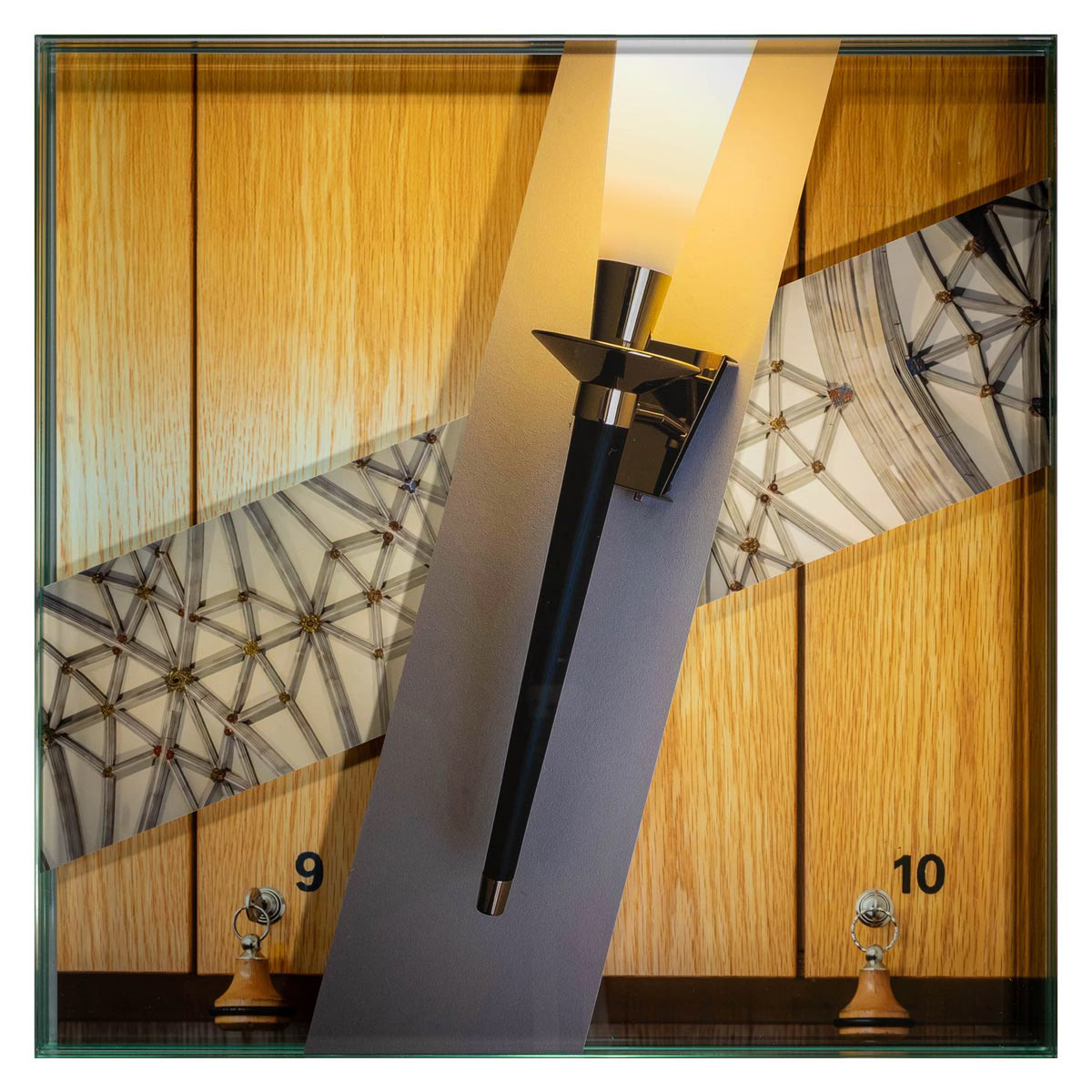
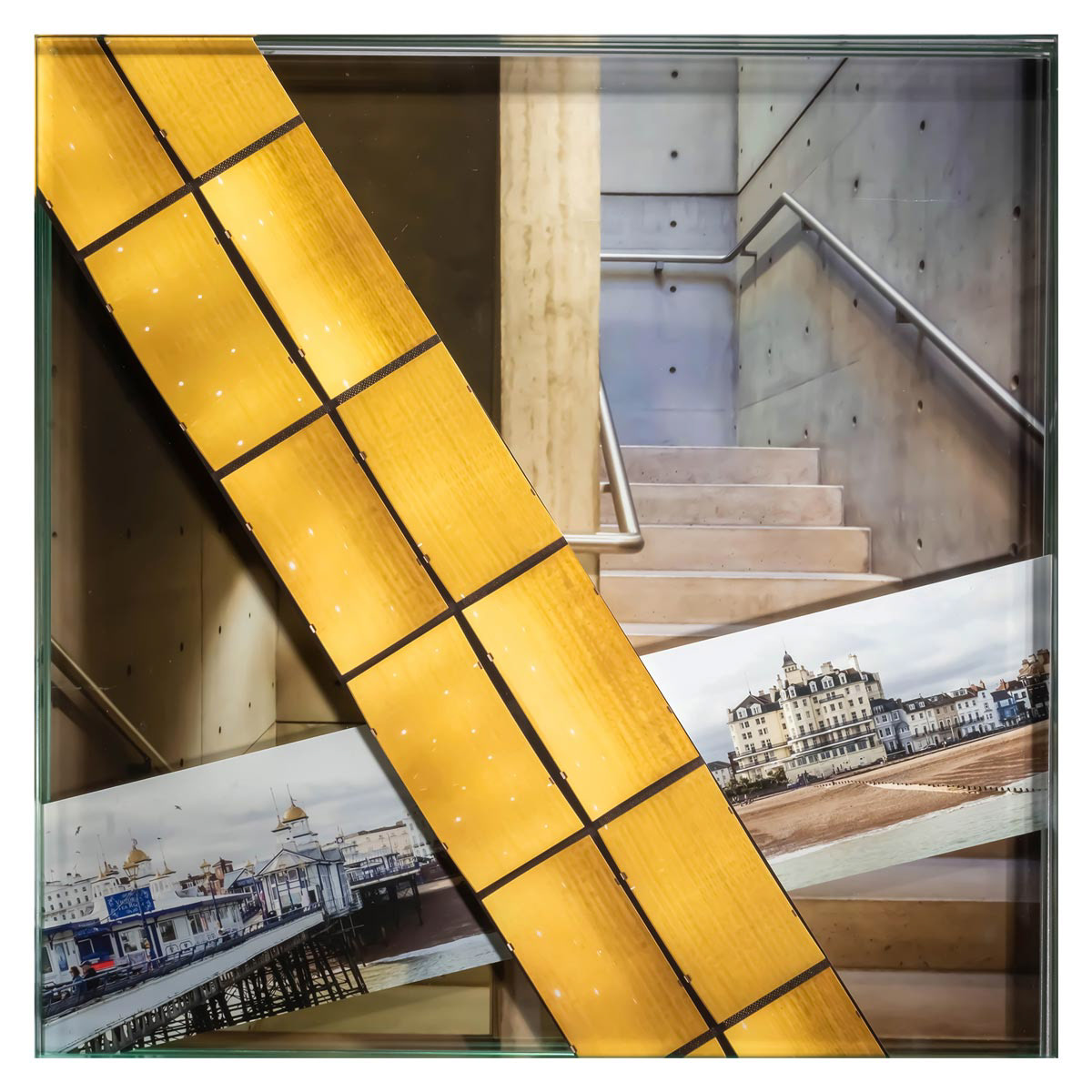
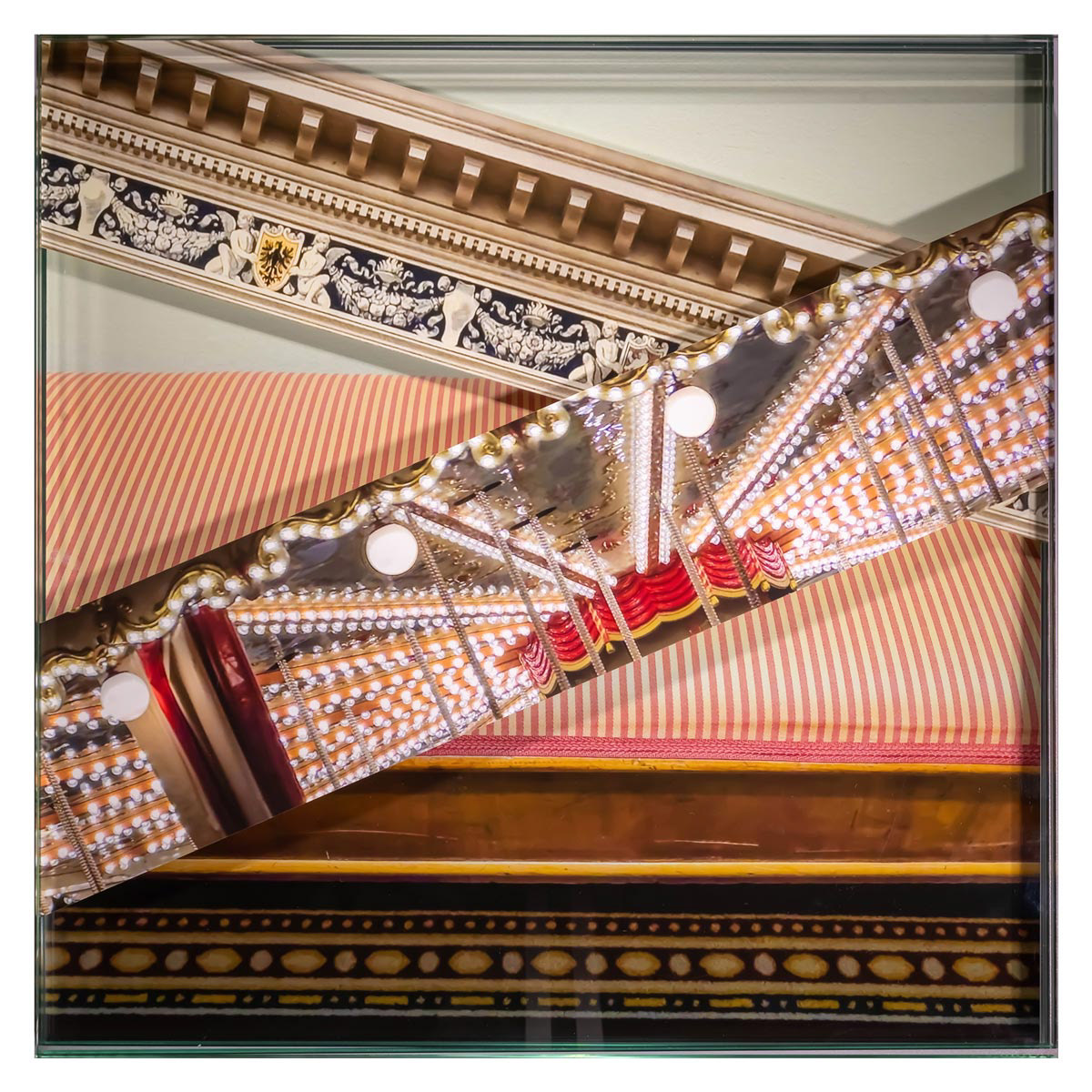
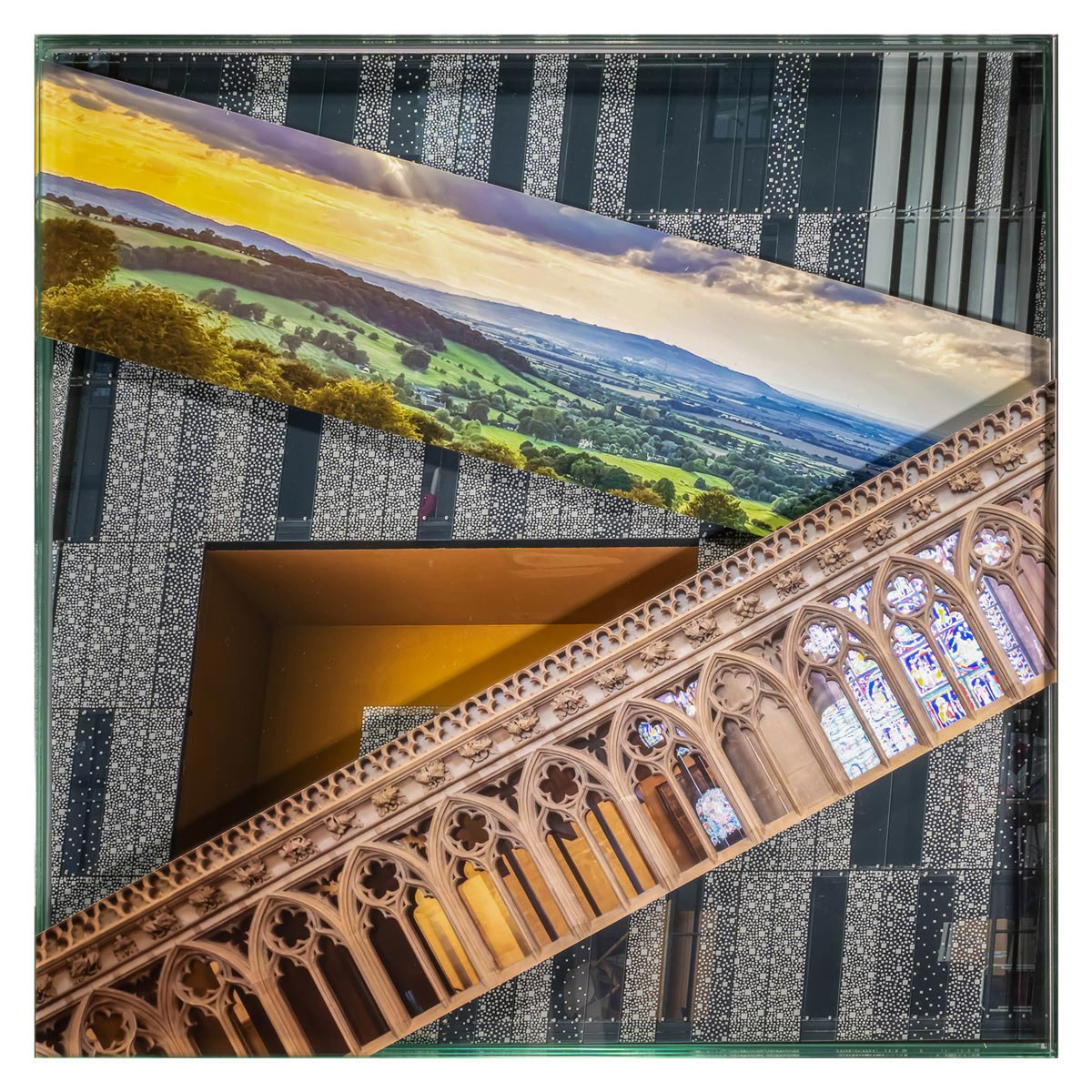
The chapter comprises 16 digital collages. They are created using a multi-layered process: A photographic base image lies behind a 5mm thick pane of glass. Image strips and further 5mm-thick glass plates are alternately layered on top – the entire arrangement is then photographed.
The resulting images create depth, refraction and fragmentation. They have no illustrative relationship to the text – and assert their own visual order.
The accompanying text guides the viewer through an evening in The Hague – from the Amare building to the Nederlands Dans Theatre and the Portfolio restaurant. In an associative dialogue, a composer and an artist approach the theme of abstraction: in music, dance, art and cuisine. They talk about order without narration, about structure as a sensual experience – and about reduction as a form of aesthetic ethics.
The complete image and text version can be found in the book Calimed image, available in the shop.
Chapter Three: Tapping your feet, nervous
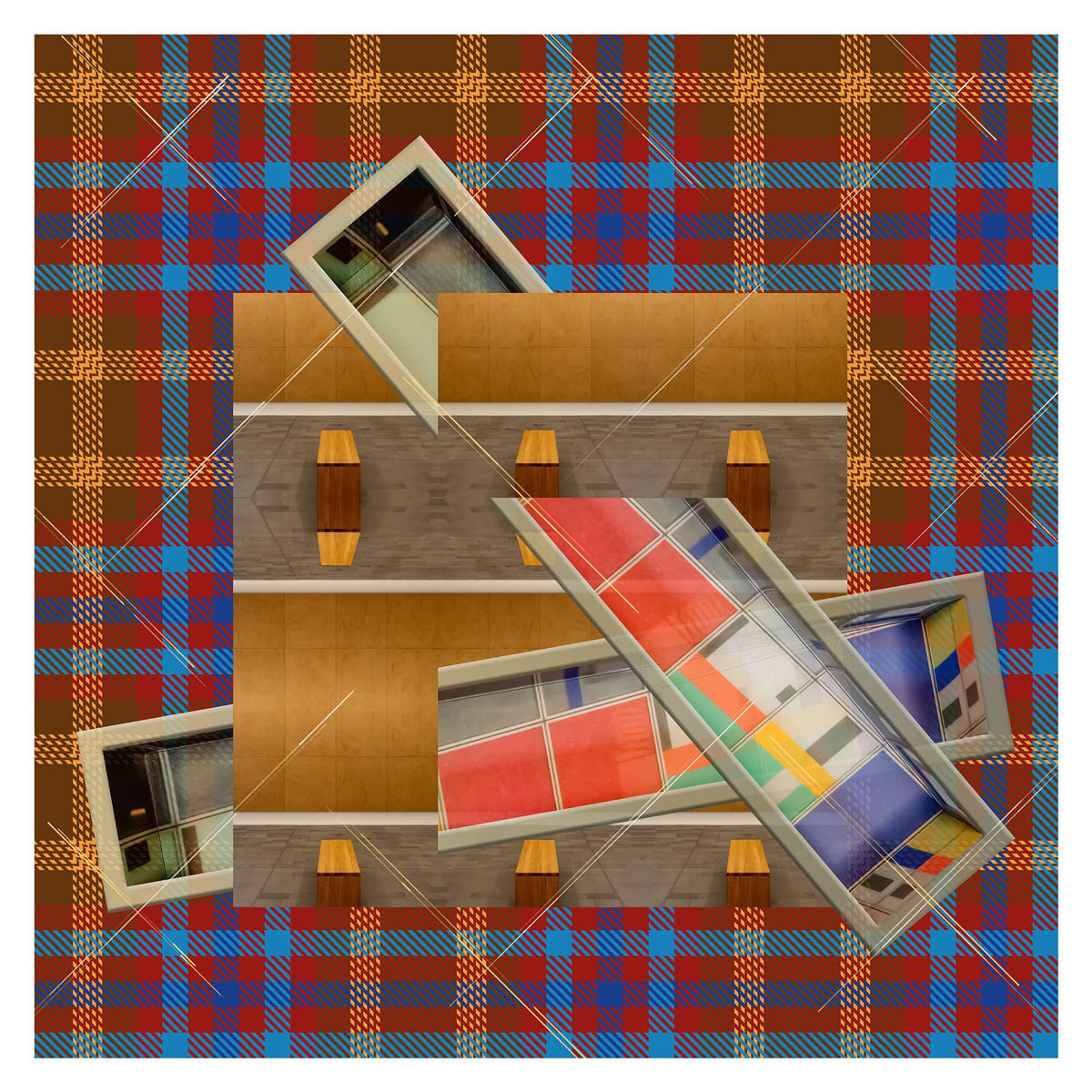
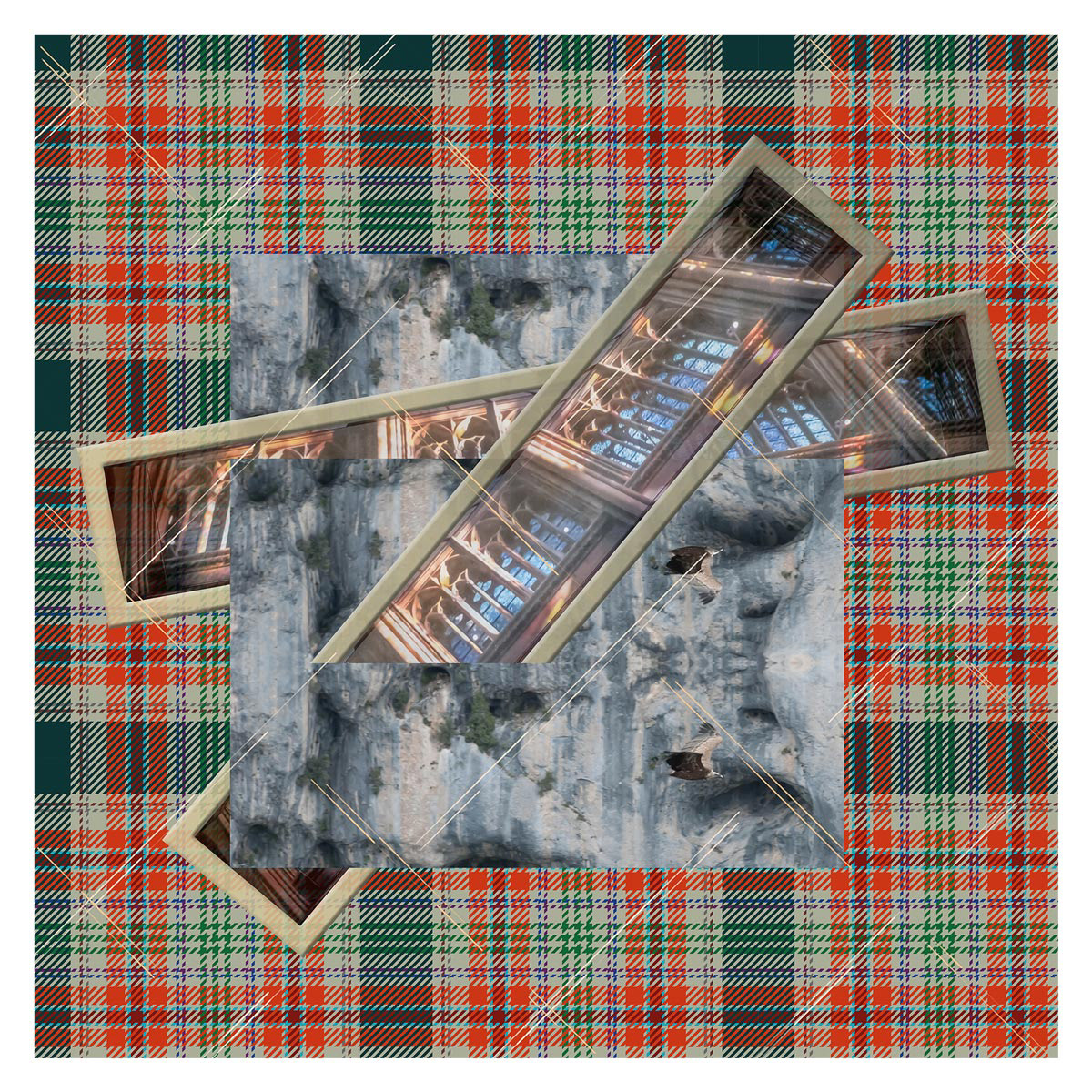
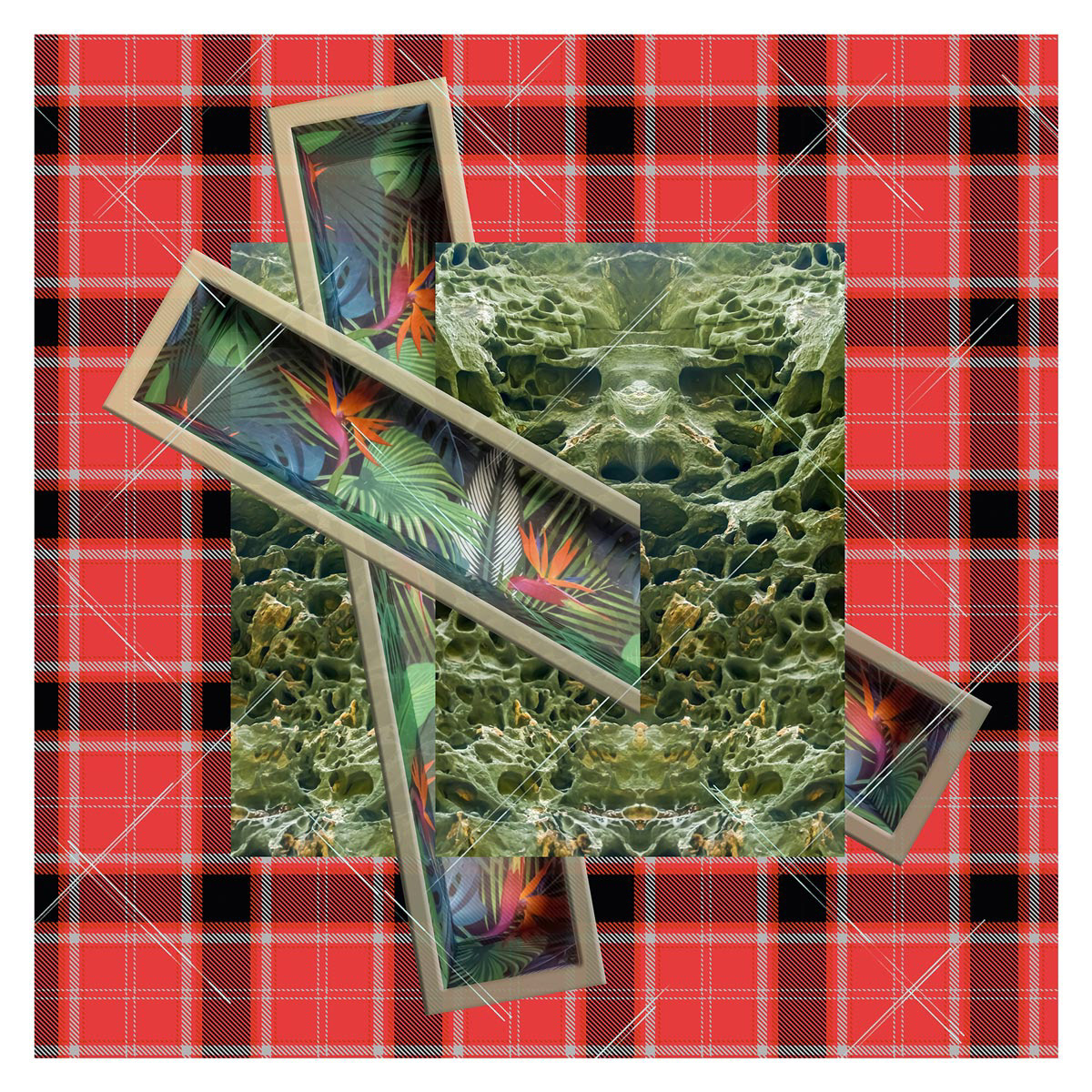
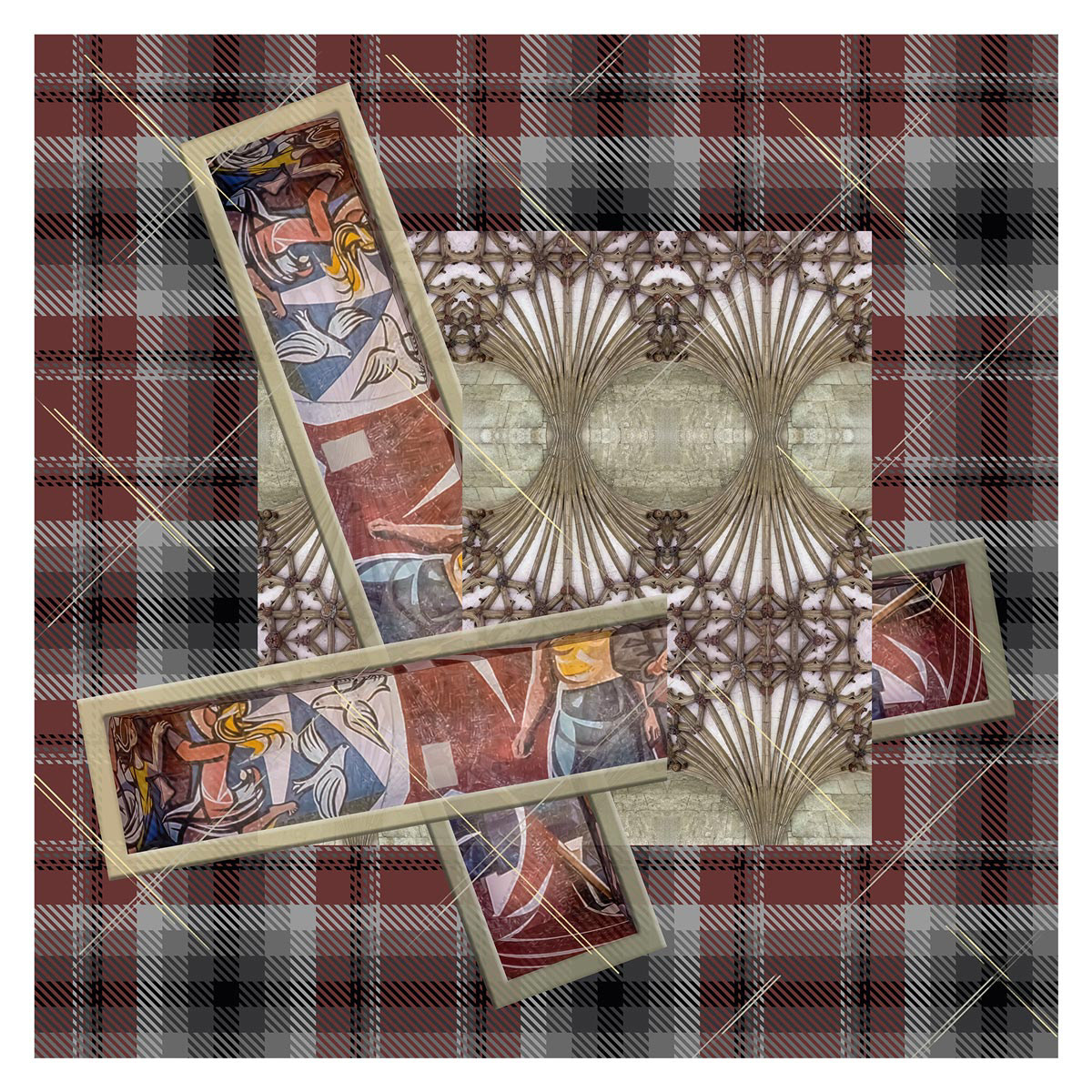
Chapter Three also comprises 16 digital collages. The starting point is strips of images printed on paper, folded into flat tubs and photographed again. These tubs are digitally woven into a grid of recurring image fragments and backed with a large-scale tartan pattern.
This creates a visual structure of repetition, irritation and spatial alienation – independent of the narrative course of the text. The accompanying text follows a cycle tour through De Biesbosch National Park and an evening at Villa Augustus. Between the water landscape, restored industrial heritage and sustainable hotel architecture, a multi-layered conversation unfolds about nature as a construction, art after the catastrophe and the parallels between new music and visual art – especially in the context of post-war modernism. It is about zero points, abstraction, reduction – and the political burdens of aesthetic systems of order.
The complete image and text version is included in the book Calimed image – available in the shop.
Chapter Four: Snapping your fingers, appreciative
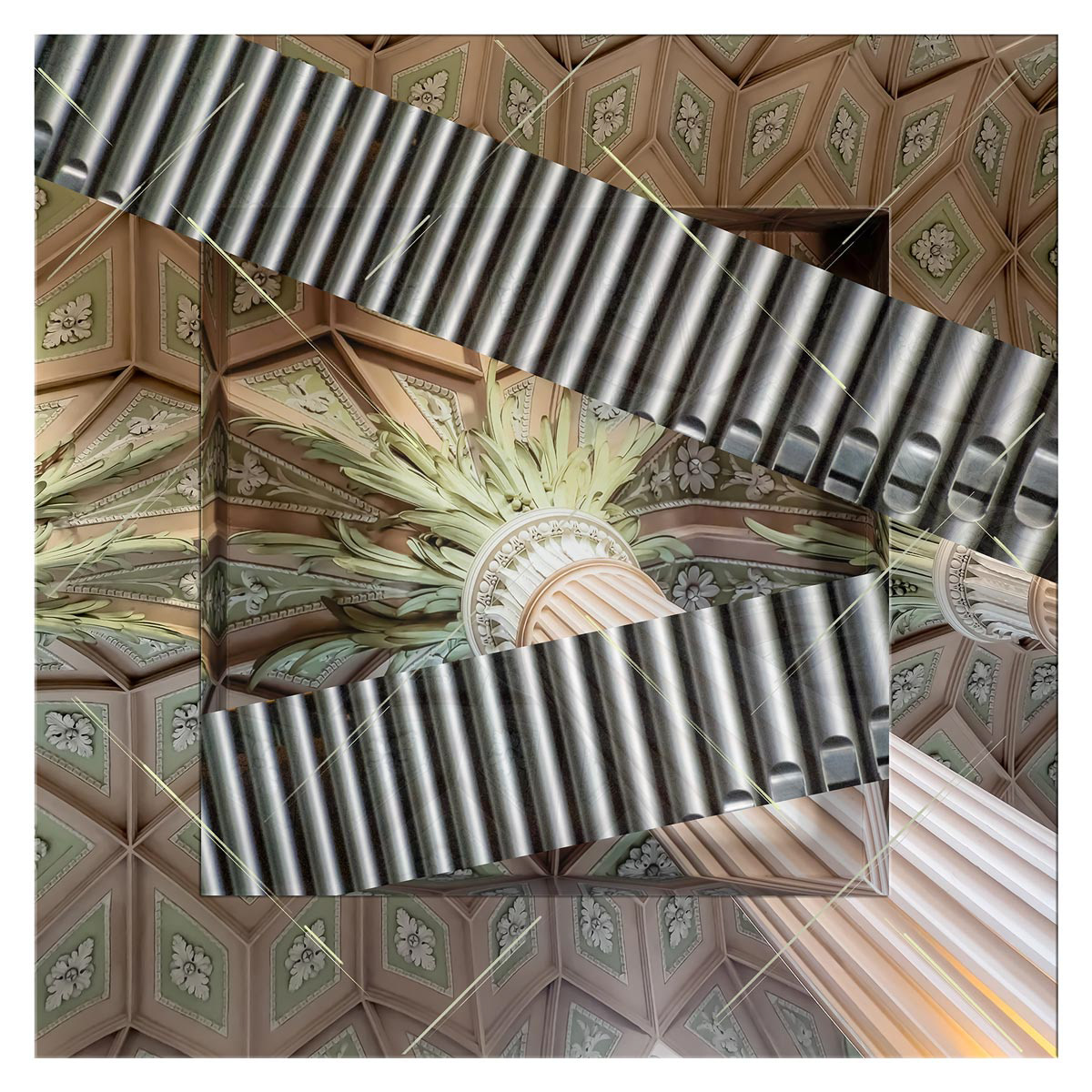
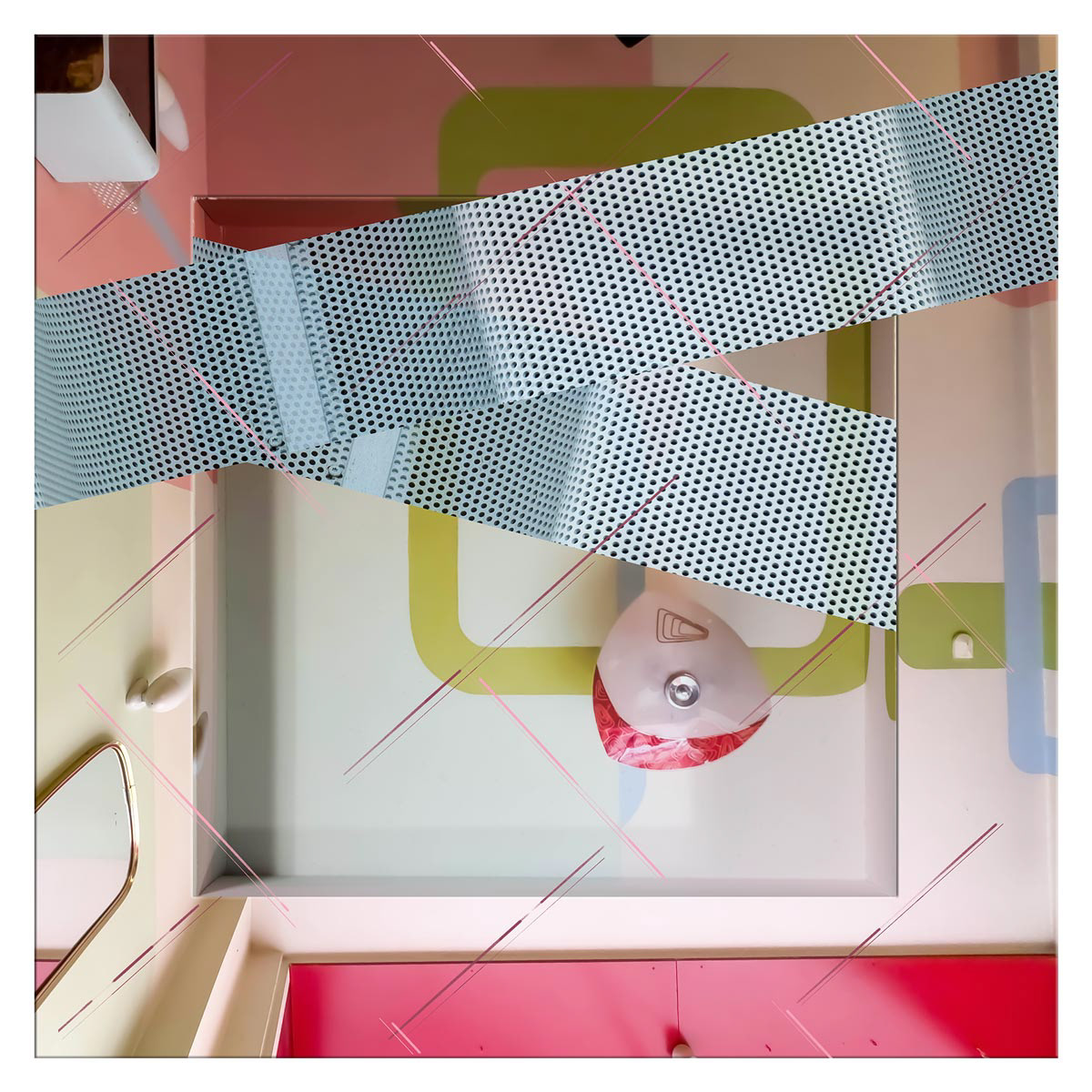
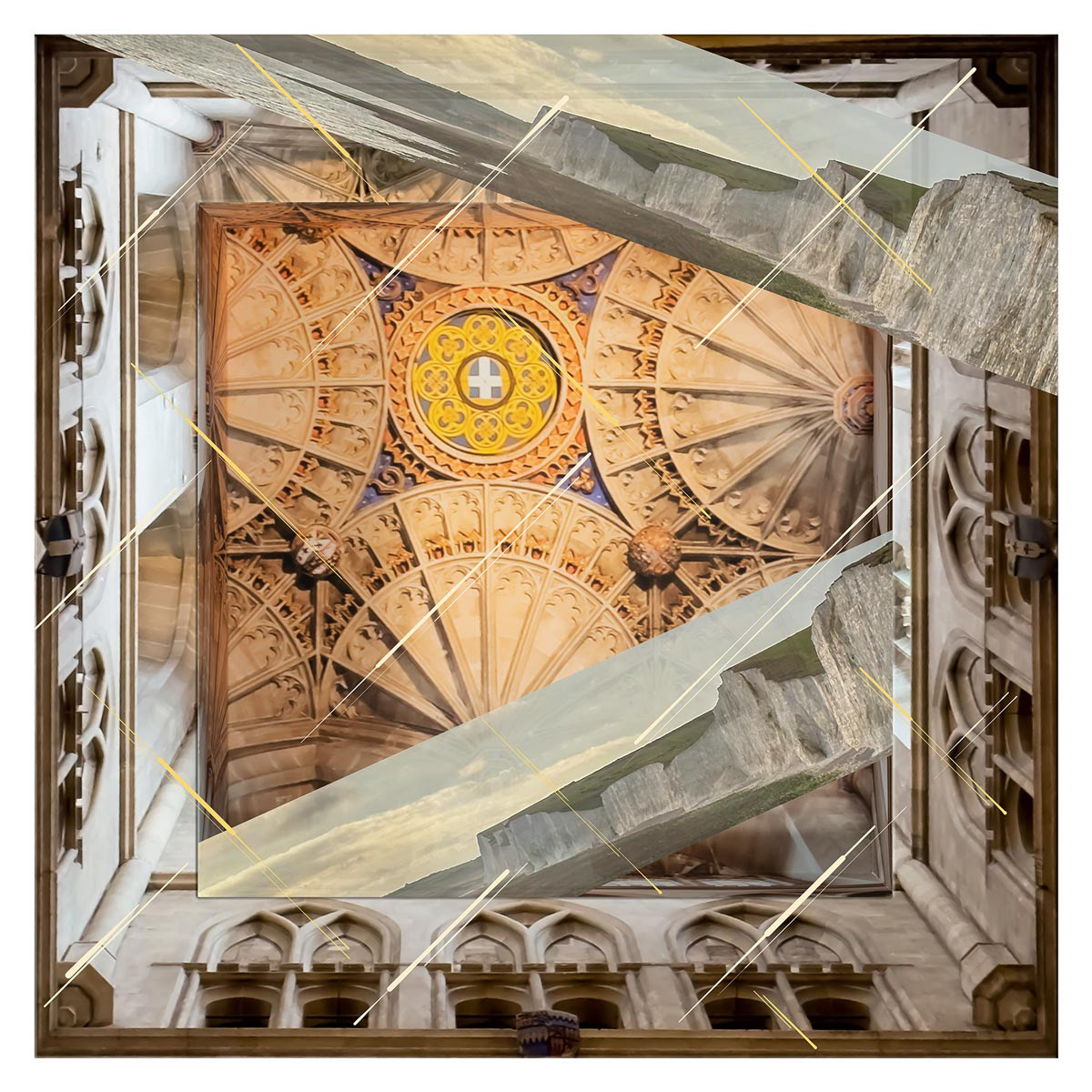
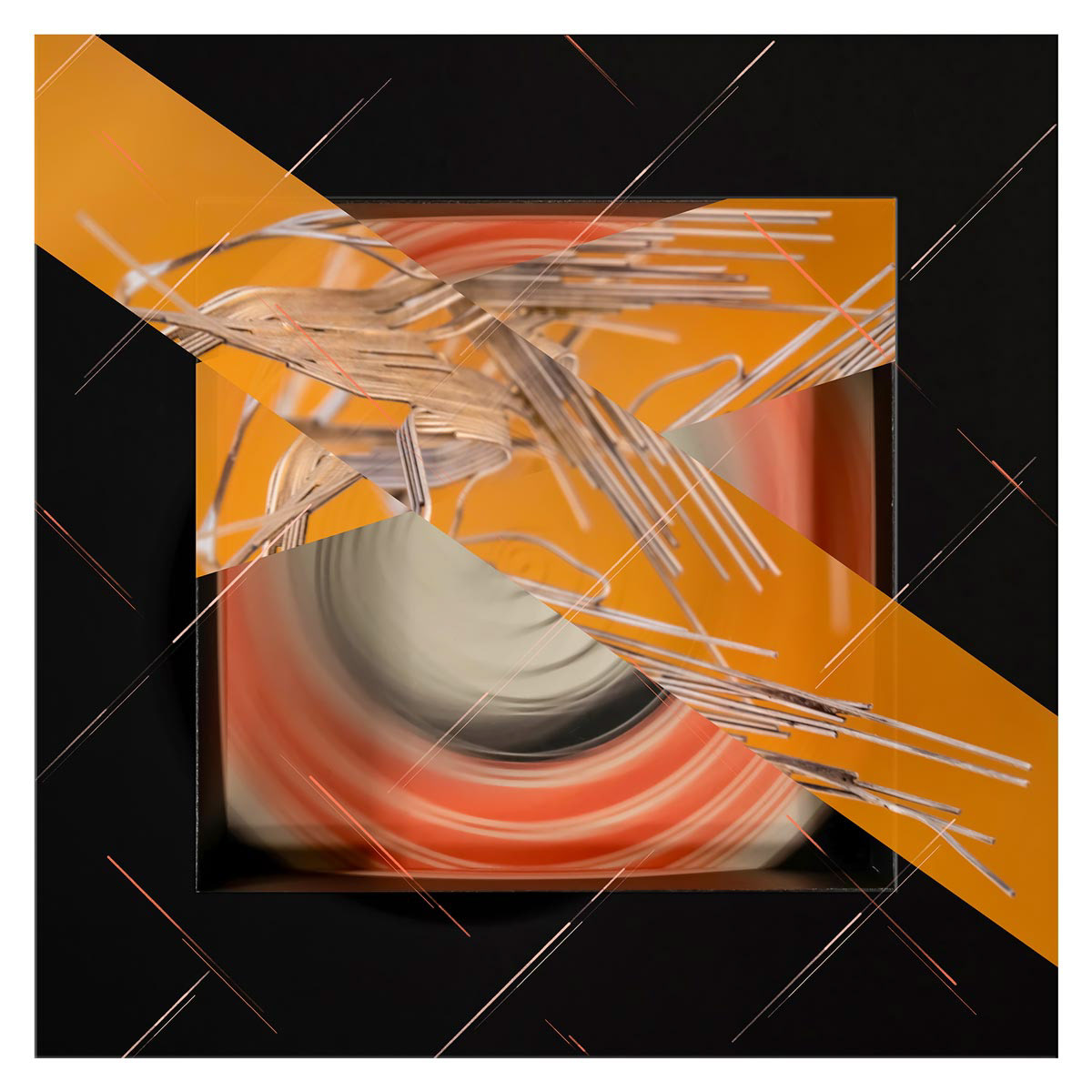
The starting point for the 16 digital collages in this chapter are strips of images printed on paper, which are folded into square tubs and reproduced photographically. In the digital processing, these constructions are given a frame and image fragments that appear to float both above and below the edge. This creates a visual multilayeredness in which order, fragment and suspended state intertwine – independently of the accompanying text.
The text is set in the Boijmans Van Beuningen depot in Rotterdam – an oten art warehouse that promises transparency and at the same time raises new questions. The composer and the artist move through the floors of the building and discuss the return of the representational in art, the handling of melody in new music, questions of archiving, cultural funding and the visibility of artistic work. The focus is on: Legibility, authenticity and the question of what remains – beyond the market, medium and duration.
The complete image and text version can be found in the book Calimed image, available in the shop.
Chapter Five: Shaking your head, incredulous
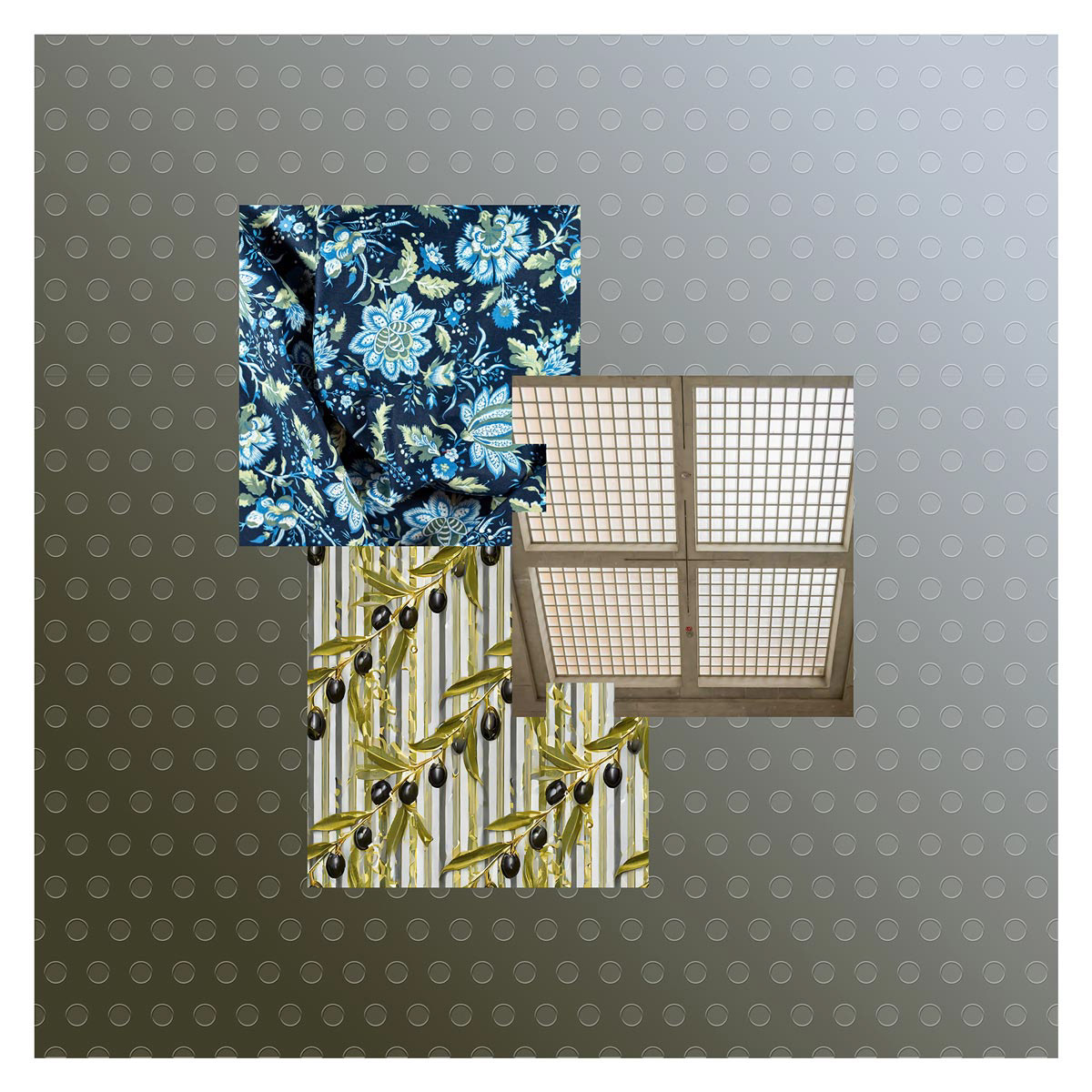
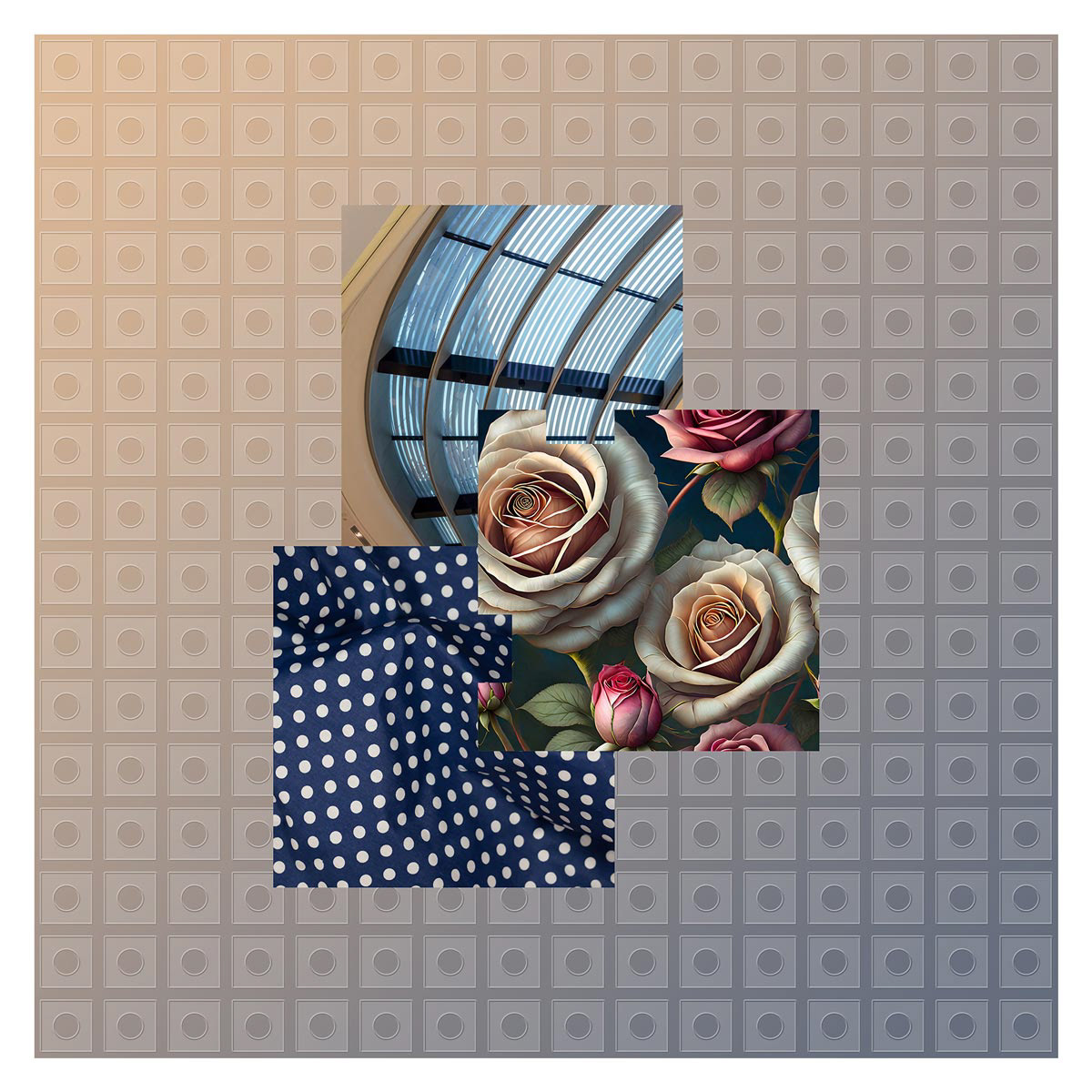
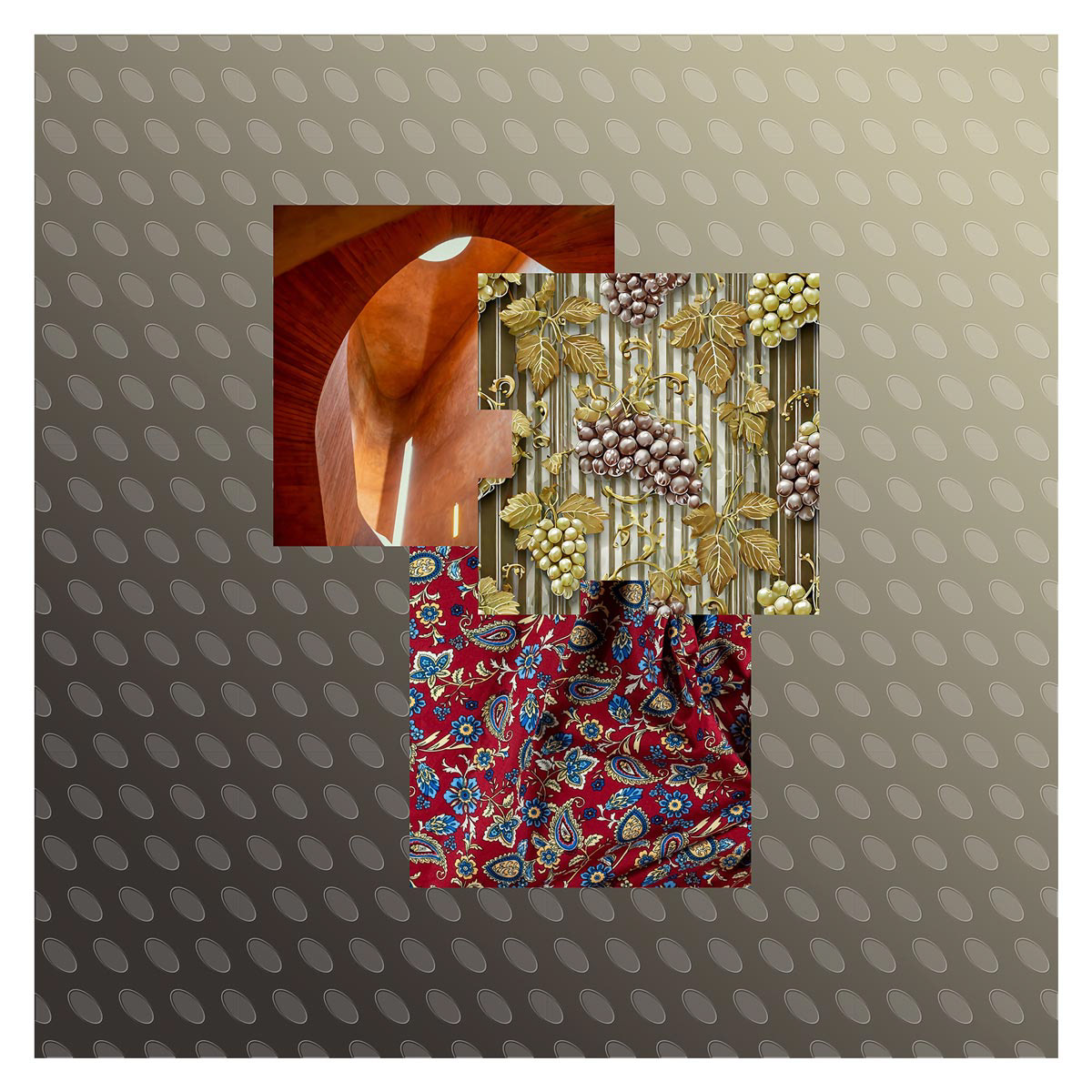
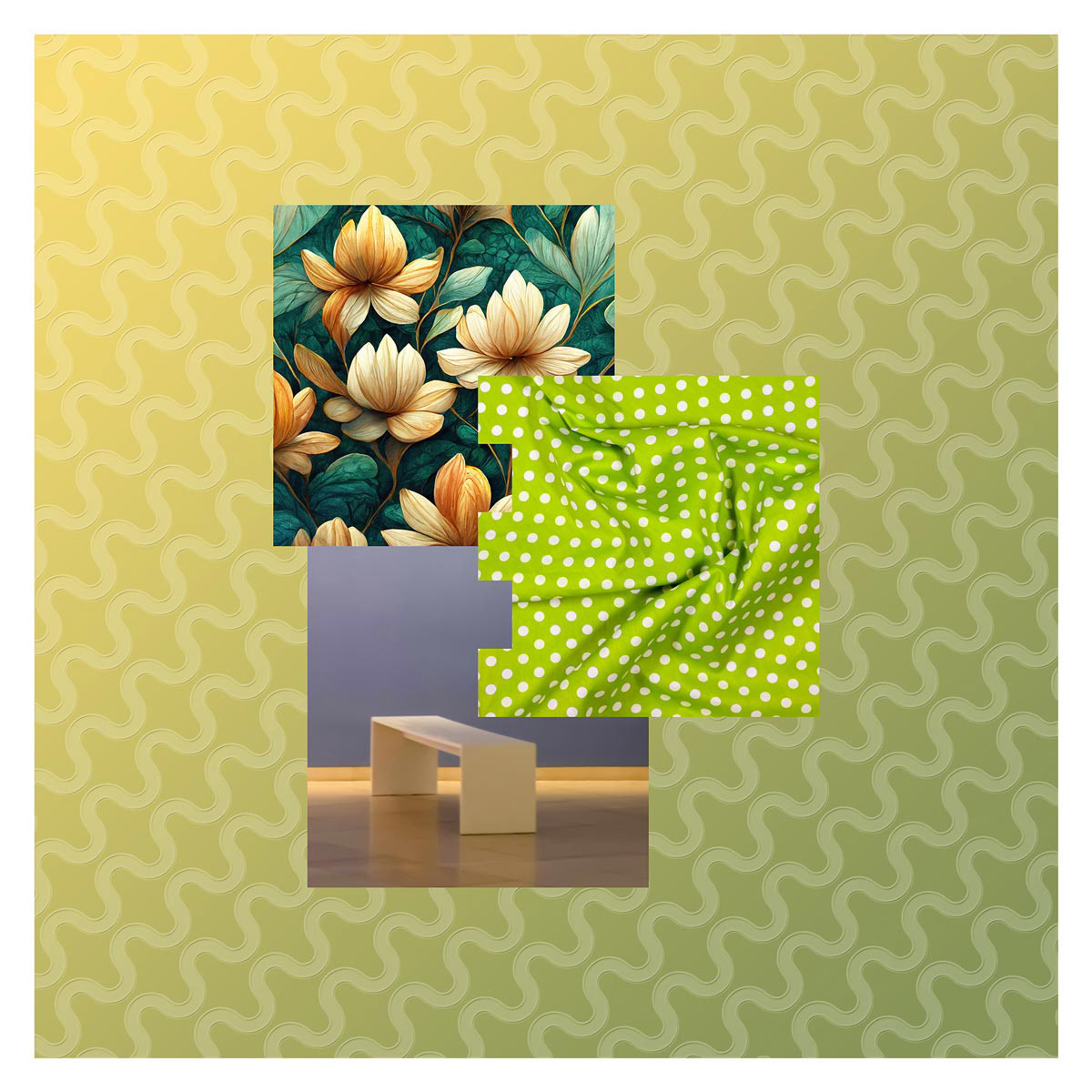
The chapter comprises 16 digital collages, each consisting of three image elements: a photographic detail, a photographed stotting pattern and an opulent – almost baroque – wallpaper design generated with AI. These image elements are applied to carrier material of different thicknesses and arranged like puzzle pieces in front of a freely constructed geometric background in wallpaper format (120×120cm). The resulting works create a relief-like field of tension consisting of surface, depth, fragment and ornament – independent of the text.
The accompanying text takes us to the Verklikkerstrand – a rough, deliberately unshaped coastal landscape in Zeeland. In the silence and uncertainty of the fog, a critical dialogue develops about nature as a strategy, artistic freedom under pressure and the fragile infrastructure of independent culture. The composer and the artist discuss coastal protection as a model for cultural practice: intervening, stepping back – and enabling free spaces. It is about visibility and relevance, political pressure, the danger of cultural control and the possibility of a new, resistant attitude to art.
The complete image and text version can be found in the book Calimed image, available in the shop.
Volume II temporary reality – 2024
Twelve experimental arrangements on the fragility of the real
At a time when reality increasingly appears to be fleeting, algorithmically mediated and politically instrumentalised, Temporary reality questions the instability of the supposedly real. The book examines the conditions of visibility and space – and how reality can be experienced as convention and construction.
The visual material comes from museum interiors: displays, showcases, architectural settings. Spaces that are usually organised, arranged and conserved appear isolated here, digitally processed, sometimes with the help of AI. People have been removed, edges added, sections reconstructed. The result is not a documentary image, but a fragile legibility – a temporary reality on revocation.
The photographs are assembled into flat boxes, striped, folded, interrupted. The pictorial space is dissected, rhythmised, its depth disturbed. What emerges is a medial in-between – neither pure image nor object, but a form of critical mediation.
Each of the twelve chapters is dedicated both to a contemporary composer and to a festival for new music. These dedications do not mark a thematic classification, but refer to attitudes, working methods and aesthetic concepts that deal with similar questions: How can structure be experienced? How can time be organised? Where does meaning begin – and what remains when order disintegrates?
The chapters bear terms such as influenced, internalised, imersed, pried open – states between perception, reflection and form. Terms that are also inscribed in new music: Resonance, friction, depth. Because music, like art, is not about representation, but about setting. Not about certainty, but about possibility.
Temporary reality comprises twelve chapters, three of which are shown on the website as examples, and only with four excerpts. Each chapter consists of 15 individual images, arranged into a block (three rows of five parts each). The individual works measure 59.4×42cm, the entire block 180×214cm. The combination of photographic material, striped structure and spatial layering creates an unstable order – visually, physically, critically.
All twelve groups and the accompanying texts are collected in full in the book Temporary reality, which is available in the shop. The works can also be purchased as real objects – each as a complete block, made of paper and cardboard.
Chapter Seven: pried open
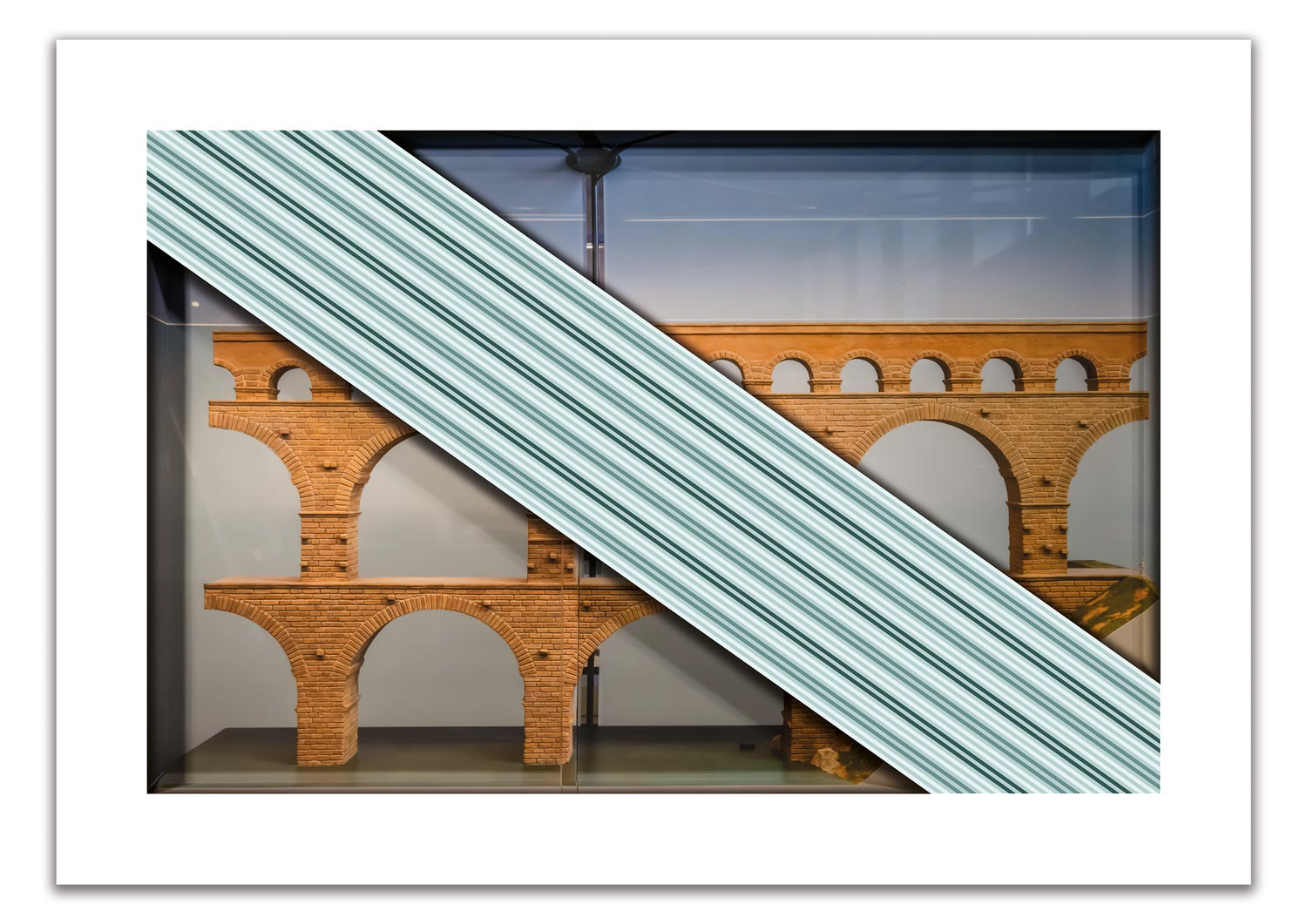
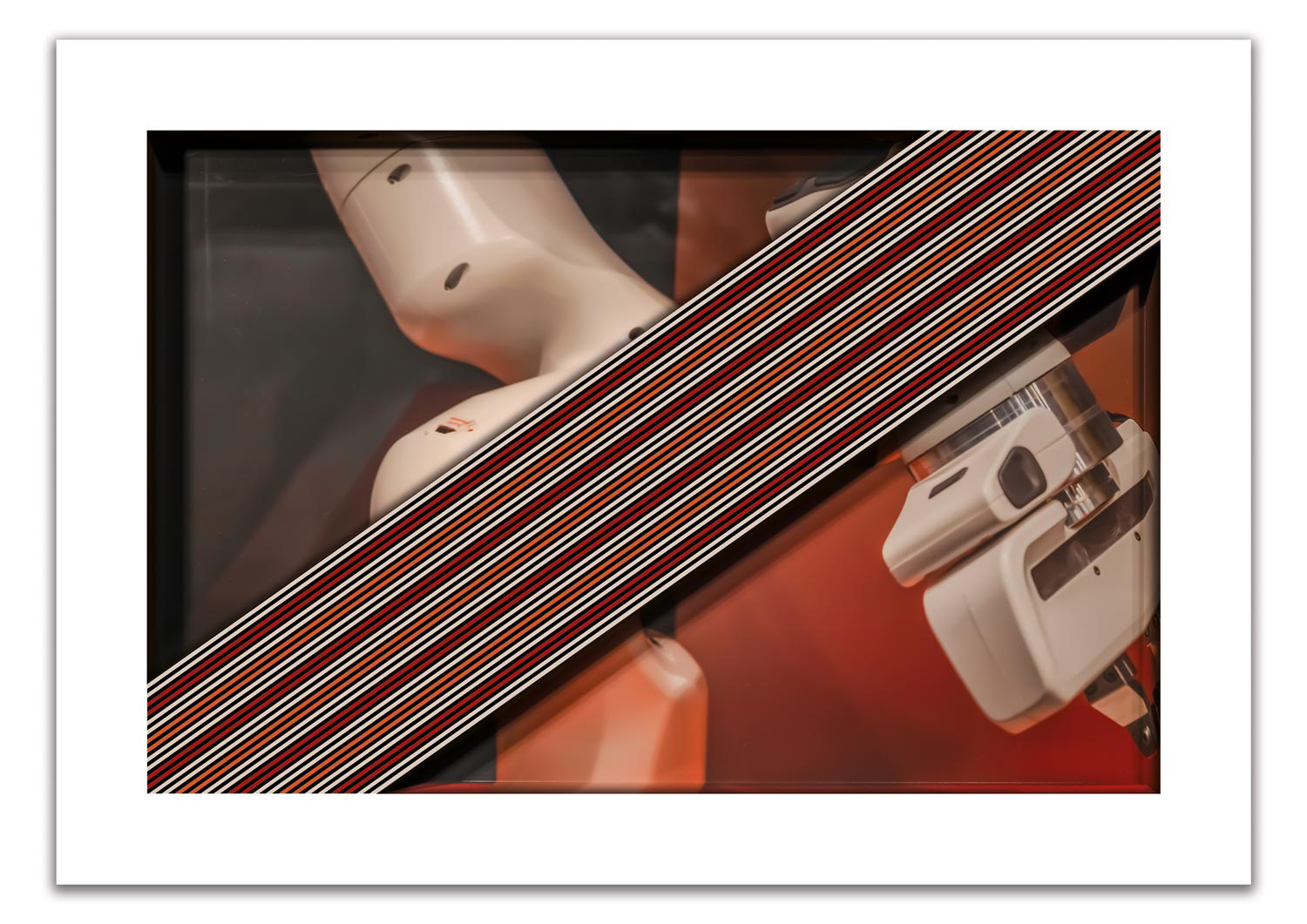
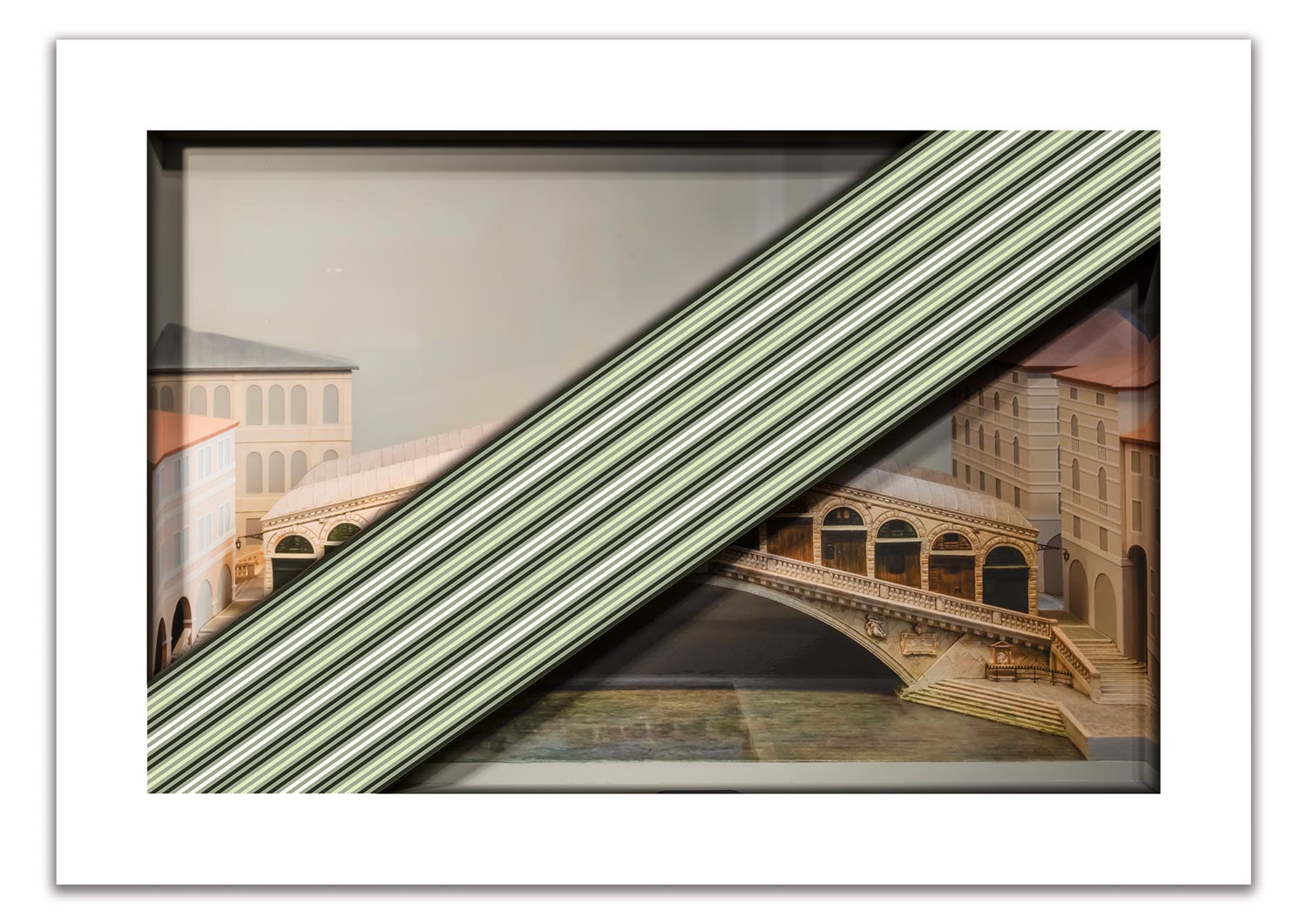
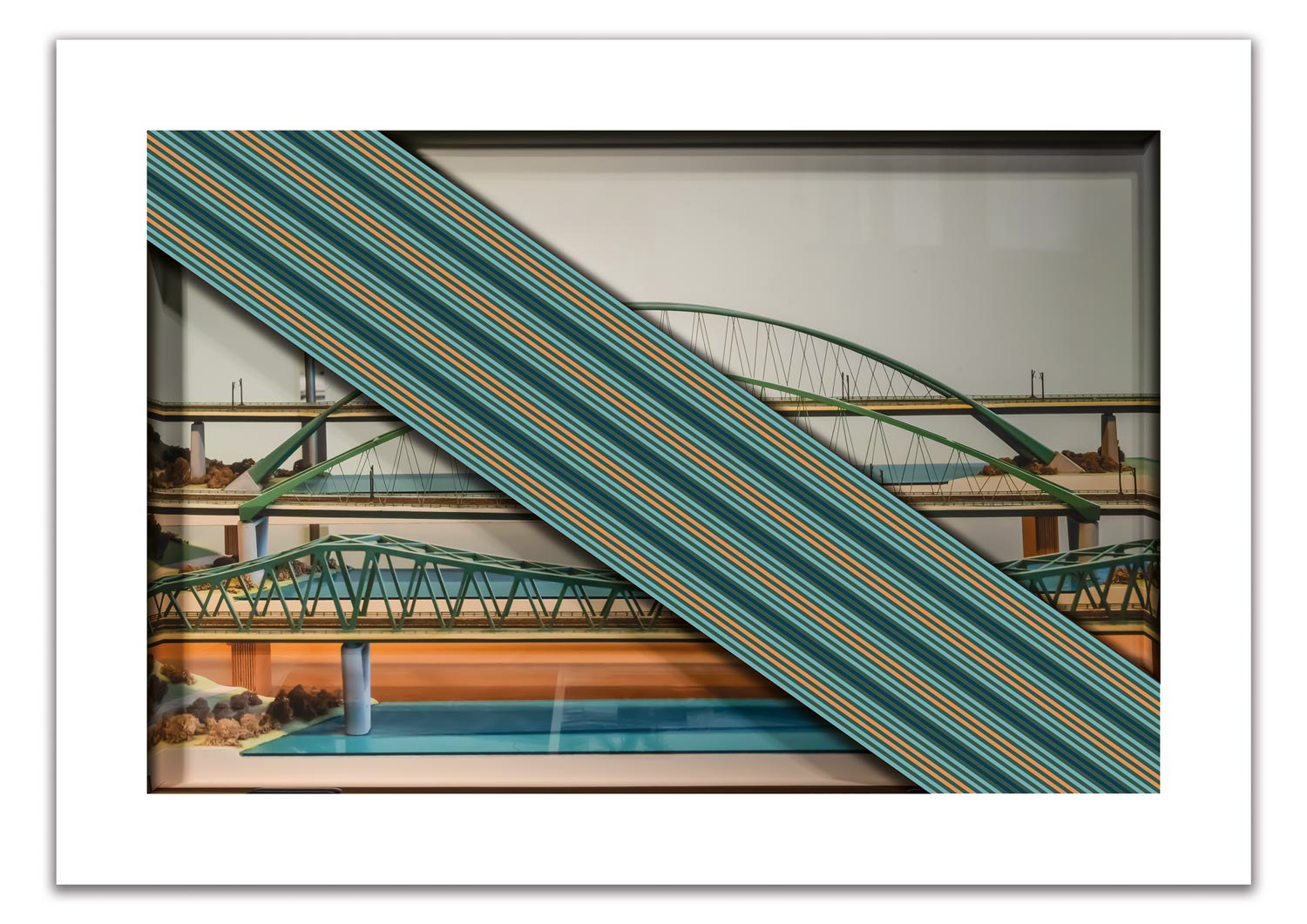
Dedicated to Phill Niblock (1933-2024) and the Kronos Quartet
AuЫrechen – that means: to leave something. Or: to ossify something. The seventh chapter of Temporary reality, which is dedicated to the US composer and sound artist Phill Niblock and the Kronos Quartet, operates in this field of tension.
Niblock's work stands for radical reduction: long-lasting tones, microtonal overlays, music without a climax – but full of inner movement. It demands attention, patience and physical presence. No narrative, no expression – but: a state. His compositions are both acoustic spaces and physical experiences – precise in sound, yet otten for perception.
The Kronos Quartet has also broken up the classical string quartet: through collaborations with composers from a wide variety of backgrounds and by crossing the boundaries between the concert hall, performance and pop culture. The collaboration with Niblock is an example of how musical form can be transformed through duration, concentration and repetition – and how this creates a collective space beyond virtuosity or gesture.
The visual material in this chapter was collected at the Deutsches Museum in Munich.
Chapter Eight: permeated
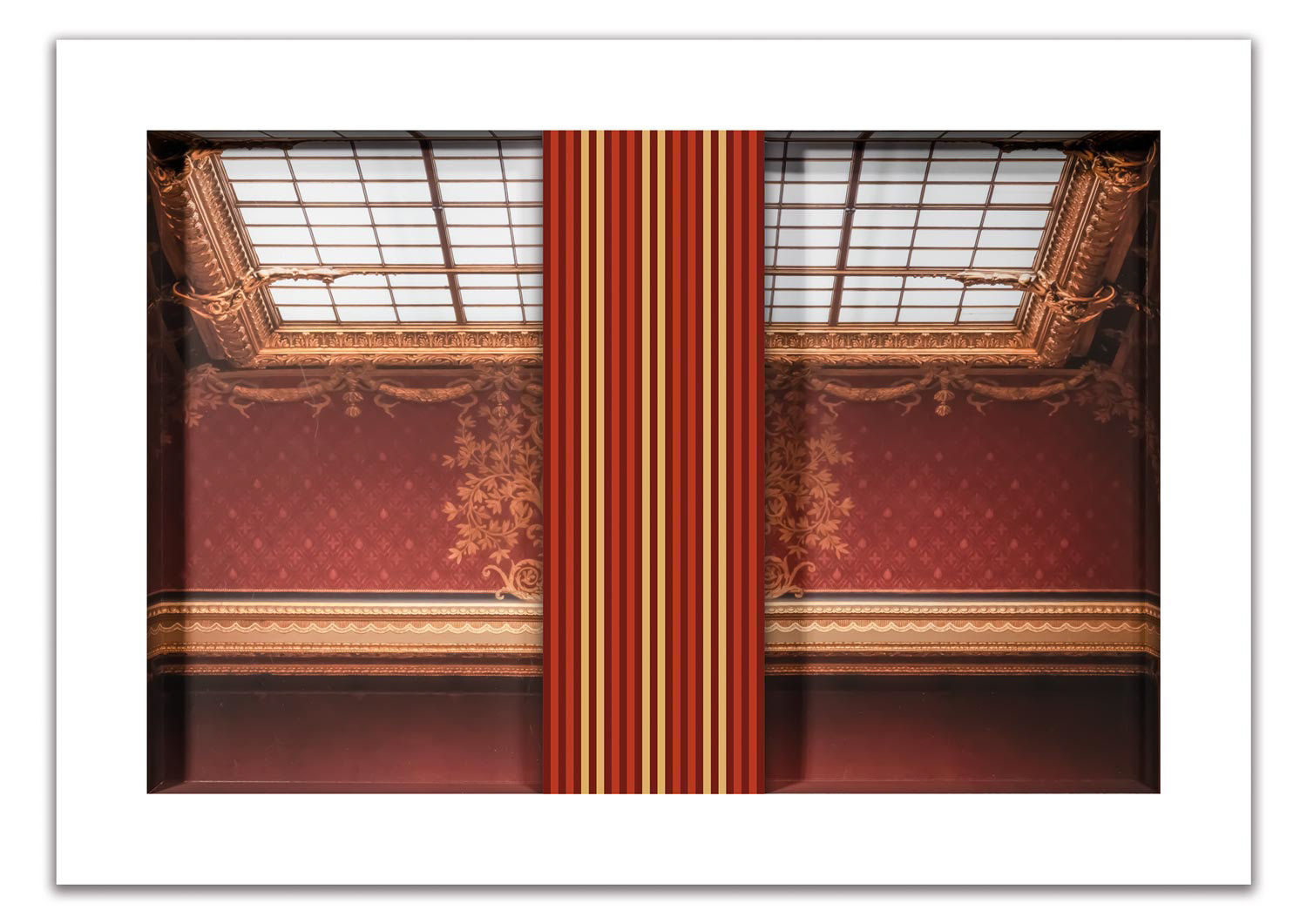
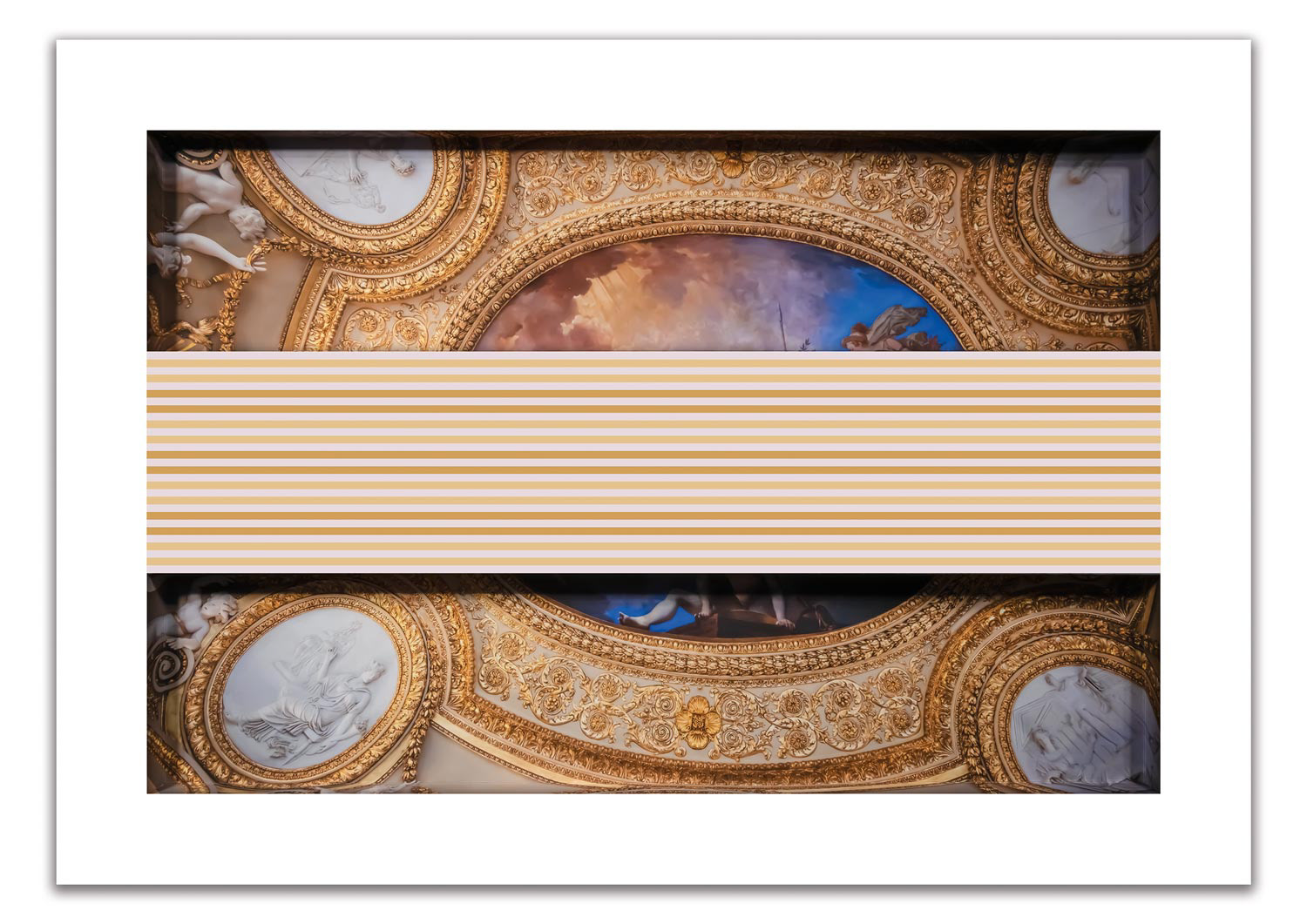
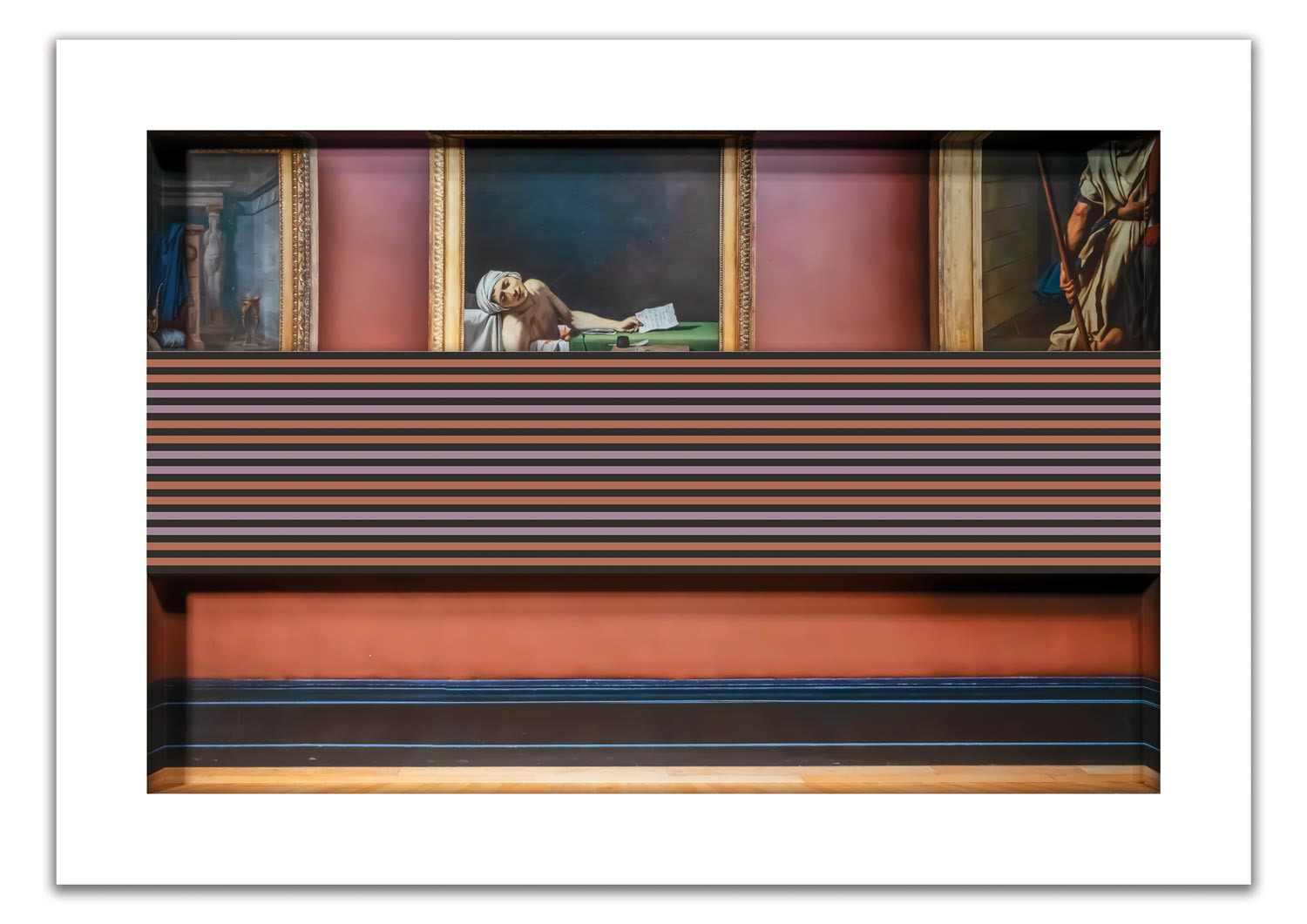
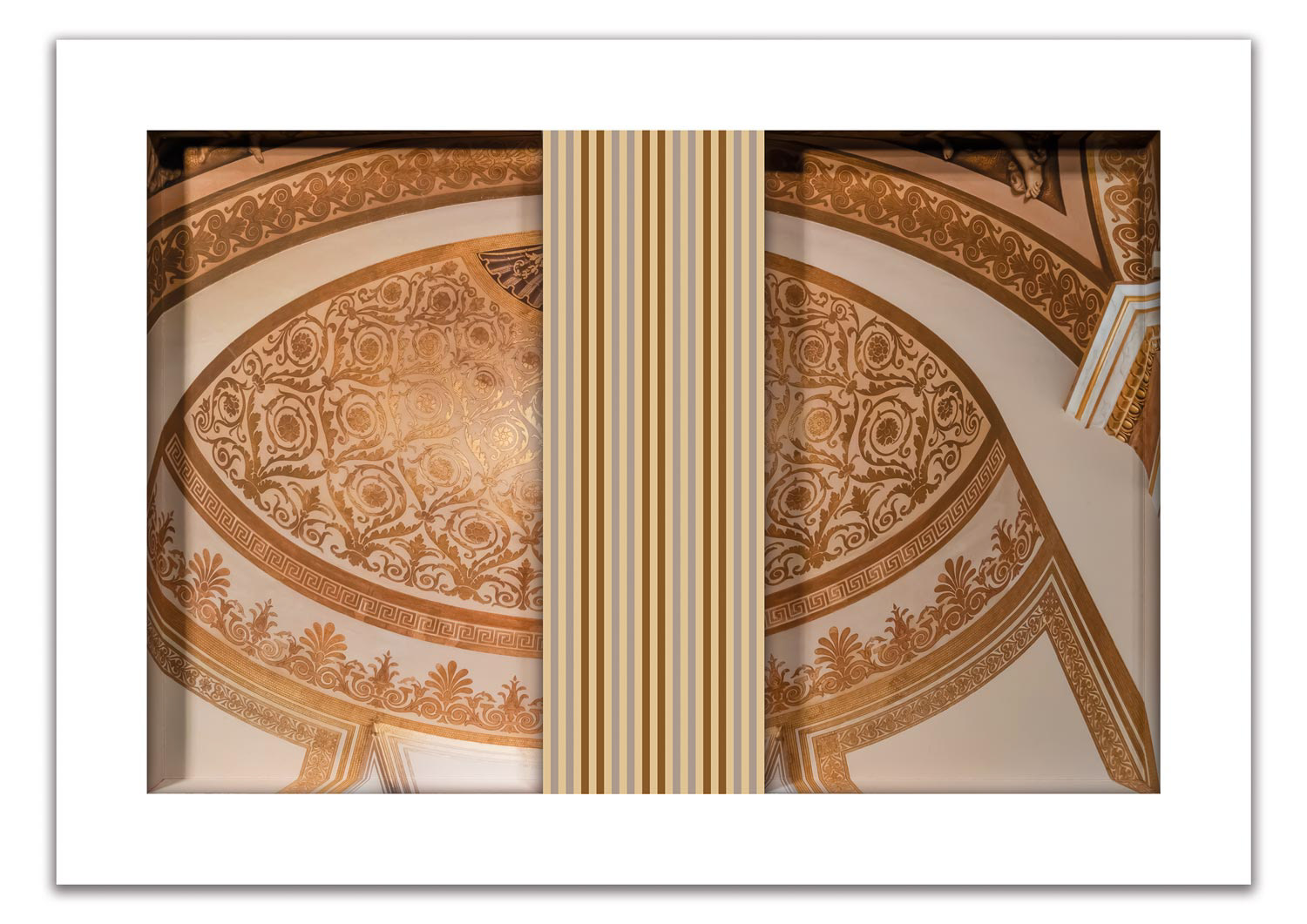
Dedicated to Enno Poppe (1969) and the ManiFeste festival
"Penetration" means more than proximity – it aims for resonance, for a movement inwards. Enno Poppe's music follows this idea: it is complex, multi-layered, physical. His pieces arise from microtonal shifts, rhythmic friction, structural density – without narrative dramaturgy, but with enormous presence. With Poppe, sound is not merely produced, but conceived, layered, cut up. A material with a life of its own that defies quick access. Poppe's works refuse to be unambiguous. They demand attention, time, listening in deep concentration – and in return offer an aesthetic of ottenness: music as a process, not as a product.
This is precisely why his work is closely linked to the ManiFeste festival – an IRCAM platform in Paris where sound research, technology and composition intertwine. Music is not only performed here, but also researched, thought through and transformed. The connection between Poppe and ManiFeste is exemplary of a different understanding of music: not closed, but otten; not decorative, but analytical; not pleasing, but demanding. In a time of quick opinions and clear positioning, this music opens up a space of in-between – restless, permeable, uncompromising.
The visual material for this chapter was collected in the Louvre in Paris.
Chapter Twelve: imersed
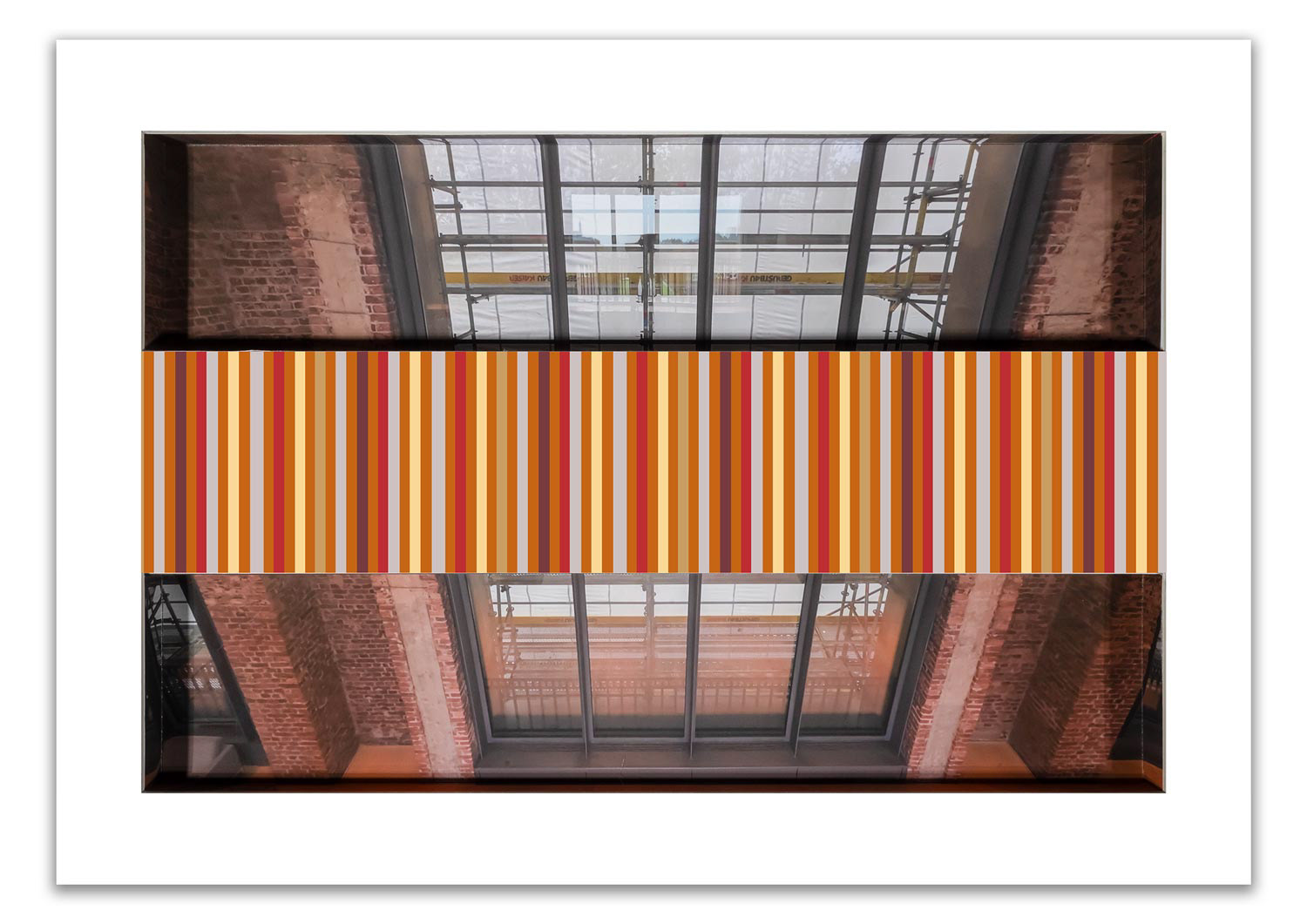
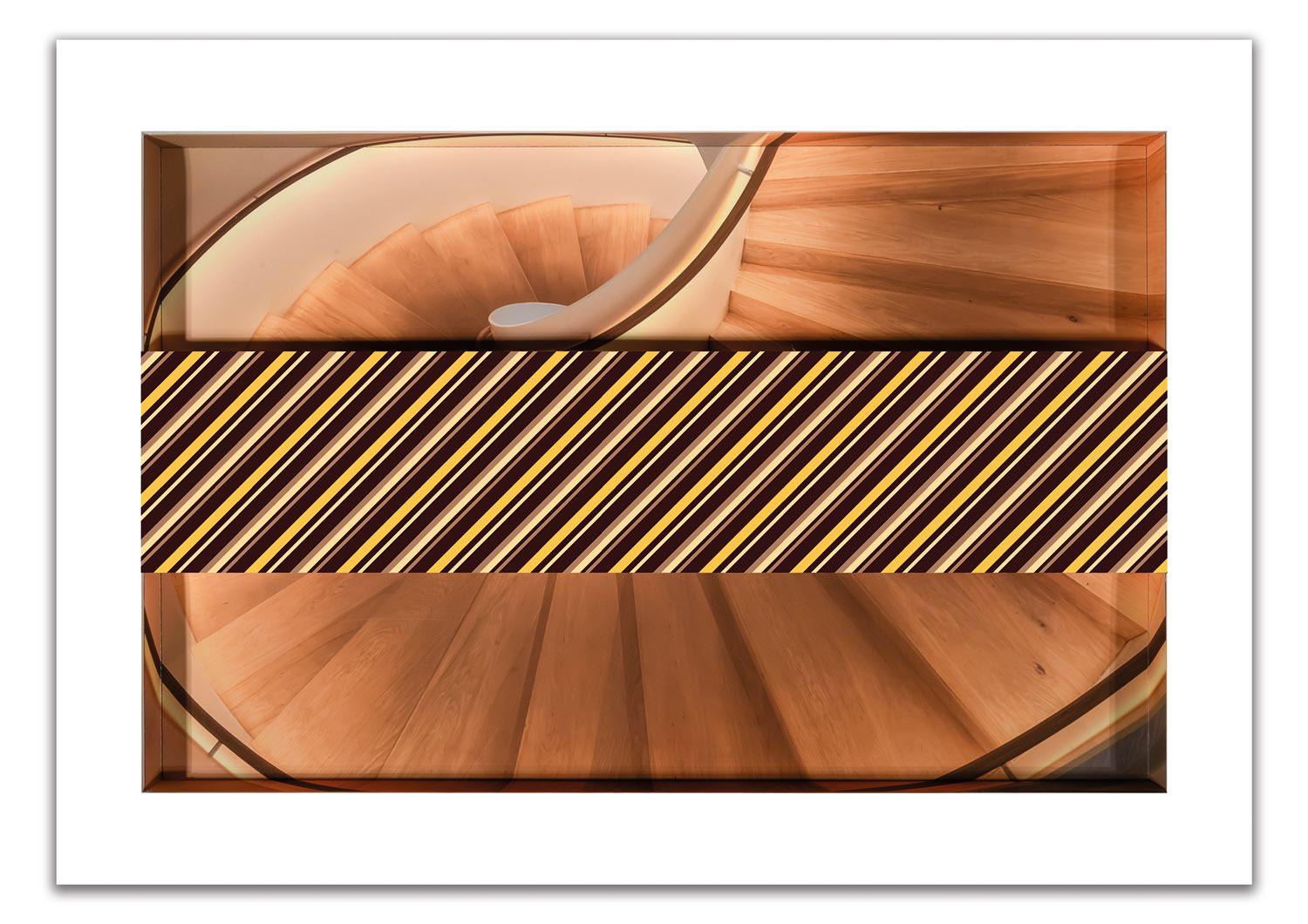
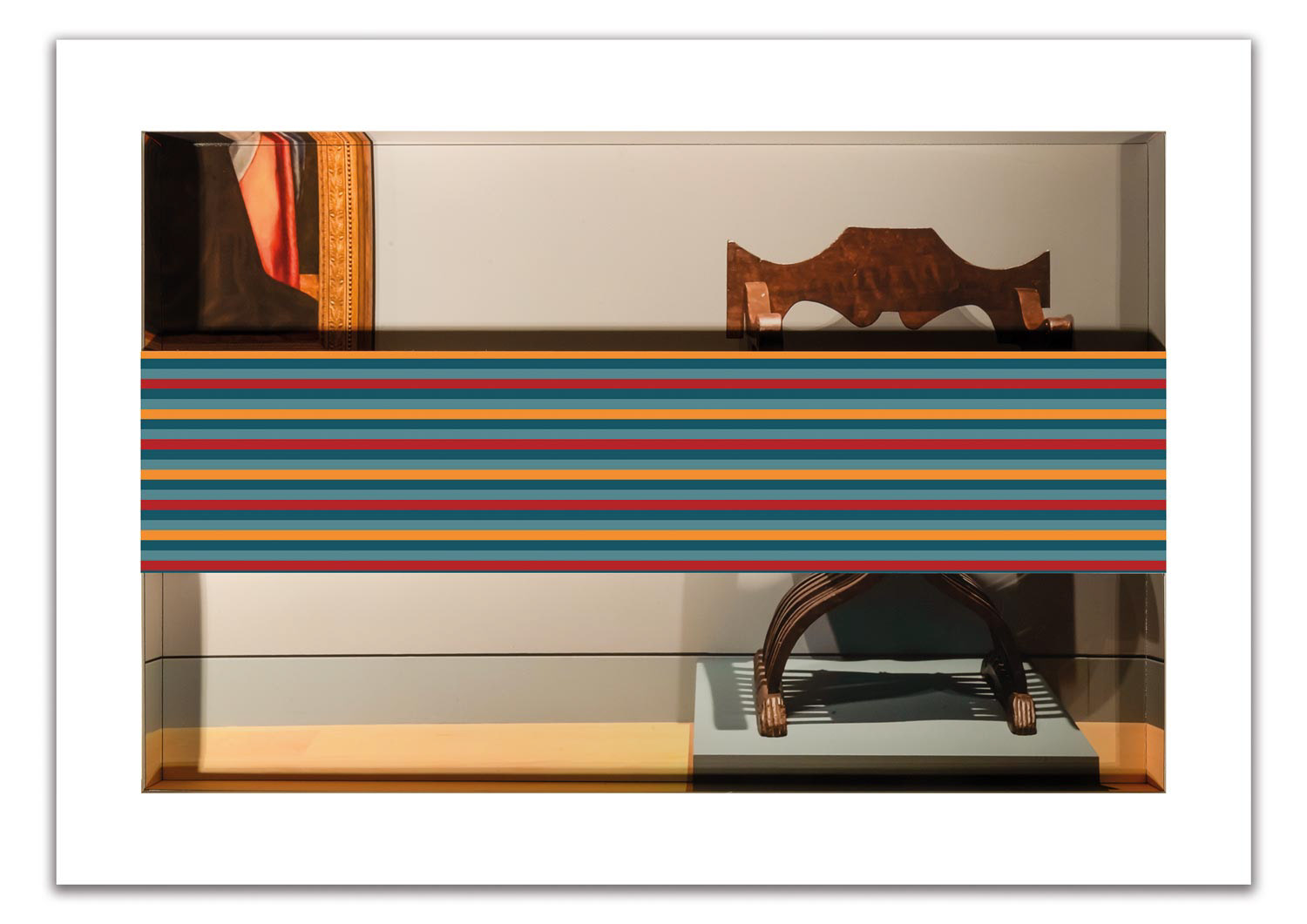
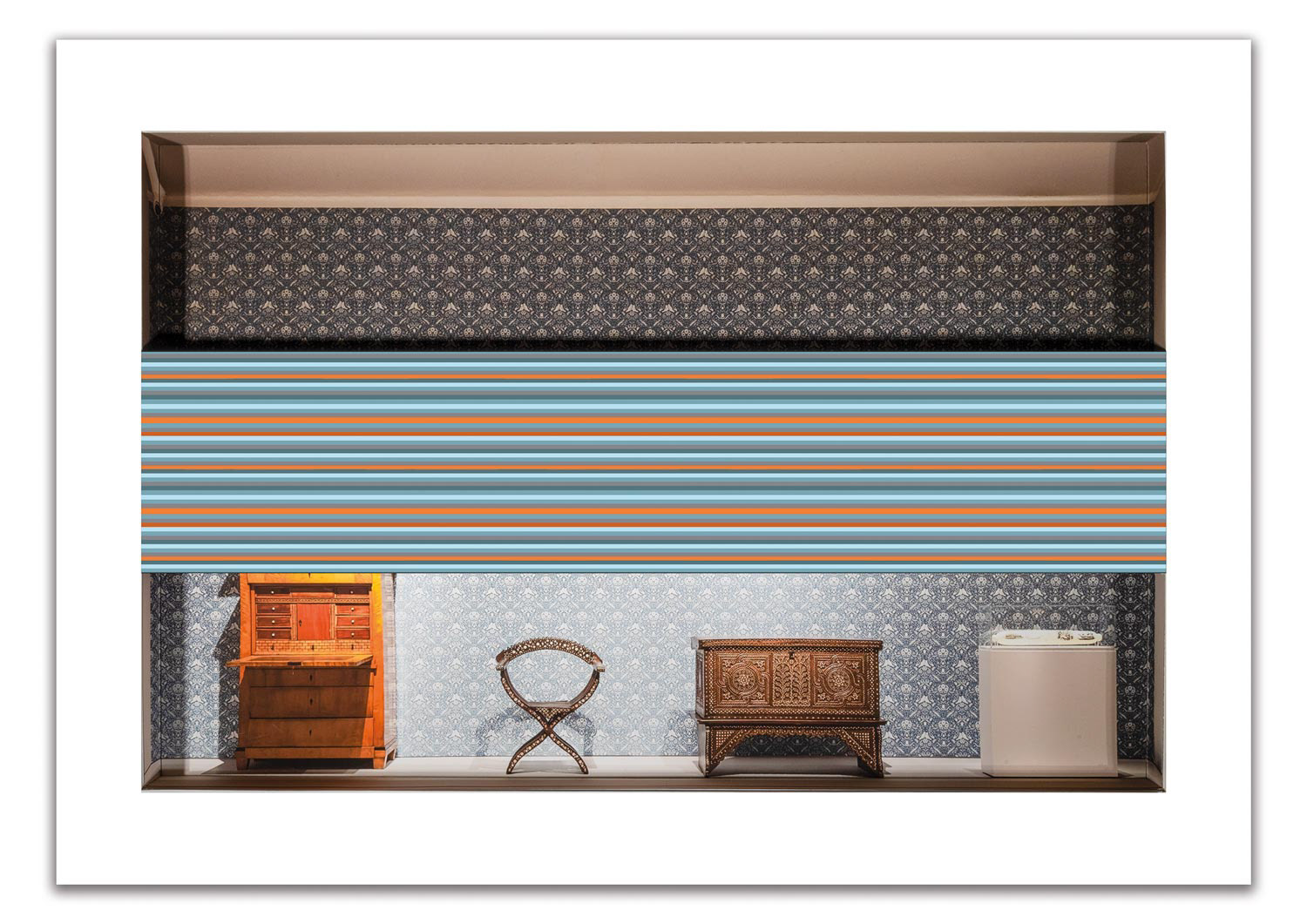
Dedicated to Jennifer Walshe (1974) and the Darmstadt Summer Courses
Immersion is not a retreat – but a focussed engagement with the world. Jennifer Walshe embodies this attitude with radical consistency: her music is voice, body, performance and theory. In her works, the boundaries between composition, documentation, analysis and action become blurred. Nothing is left out – social media, political discourse, digital self-measurement. Everything becomes material, everything is scrutinised. Jennifer Walshe uses the voice as an acoustic instrument of analysis – speaking, imitating, stuttering, decomposing. Her performances are shocks: not messages, but processes that elude quick access. With her entry into the New Discipline, she calls for a new understanding of music – situated, relational, permeable.
The Darmstadt Summer Courses are a resonating space for this practice: once a place for the post-war avant-garde, today a laboratory for contemporary art. Hybrid formats are promoted here, aesthetic contradictions are negotiated and critical voices are strengthened. Walshe is part of this discourse – not as an outsider, but as a source of inspiration. Here, immersion means critical proximity. An art that does not evade, but entangles.
The visual material for this chapter was collected at the Kunstmuseum Düsseldorf.
Volume III - Lost truth – 2025
What is still considered true today – and who decides? Lost Truth is the third and final part of the trilogy Tell me nothing. At the centre are literarily staged conversations between a composer, an artist and a film director. Their journey through England – from Dover to Bath to St Ives – becomes the framework for reflections on art, authenticity, AI, narratives, institutions and representation. Truth is not asserted, but the conditions of its creation are questioned – in doubt, in contradiction, in tentative thinking.
The images in the book also follow this idea. The source material is photographed museum spaces that are digitally alienated, expanded or refracted by real objects such as glass lenses or spheres. AI-supported retouching, perspective cuts and optical shifts create intermediate spaces: between image and construction, between presence and assertion. The result is not a documentation, but a visual argumentation – about the fragility of evidence.
The volume comprises five chapters, each with 16 works – 80 in total. Only four examples of each volume are shown on the website. The complete pictures as well as the complete conversations can be found in the book Lost truth, available in the shop.
The works are produced in three versions: 120×120cm as a digital print on non-woven paper (wallpaper-like directly on the wall), 80×80cm as a digital print behind Plexiglas, 40×40cm as a digital print on paper. In addition, the complete chapters are also hung as a block: 16 works in 40×40cm format, framed and arranged in four rows of four pictures each. Total dimensions approx. 176×176cm.
If you are interested, please contact the artist. Non-binding guide prices are available in the shop.
Chapter One: with the head tilted, fed up
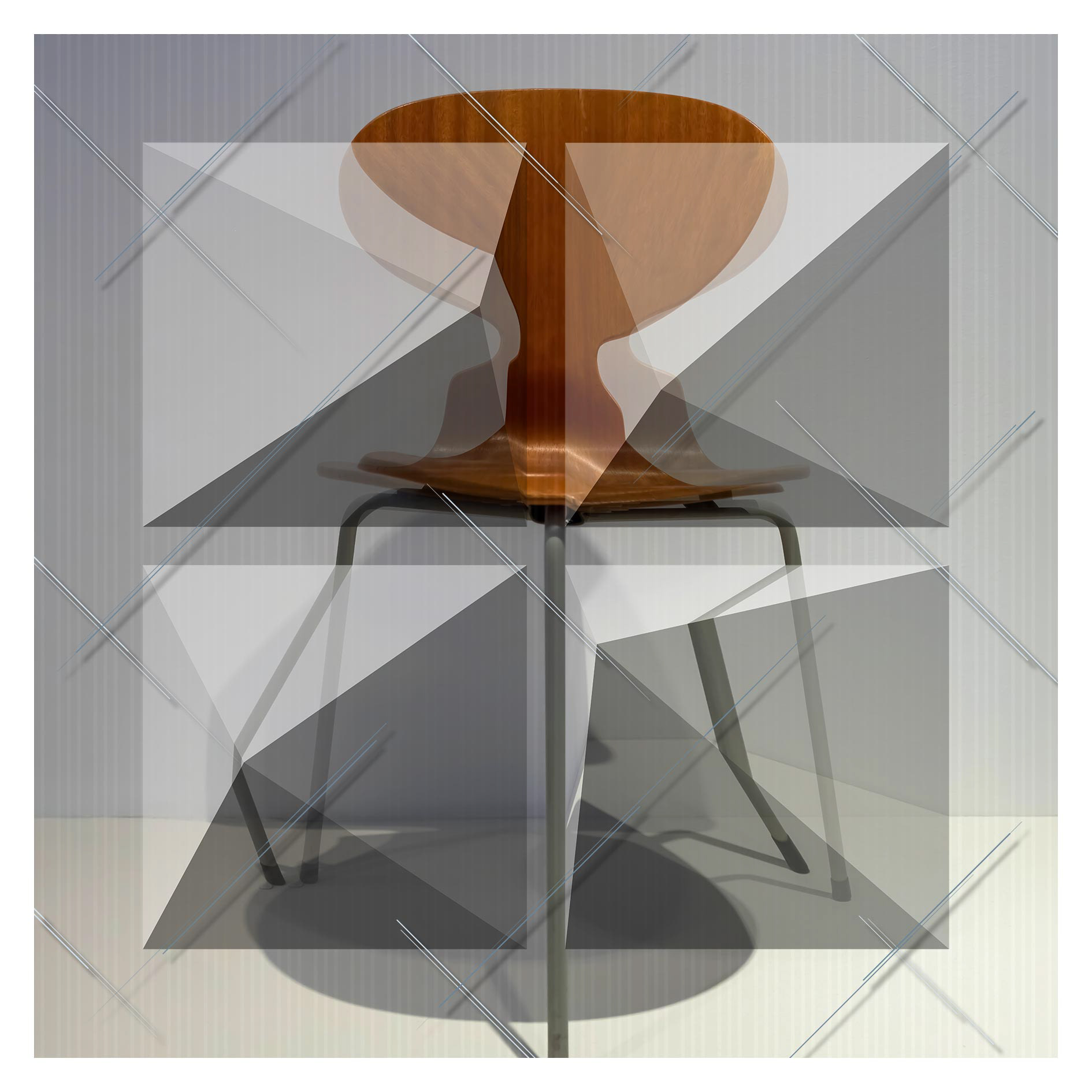
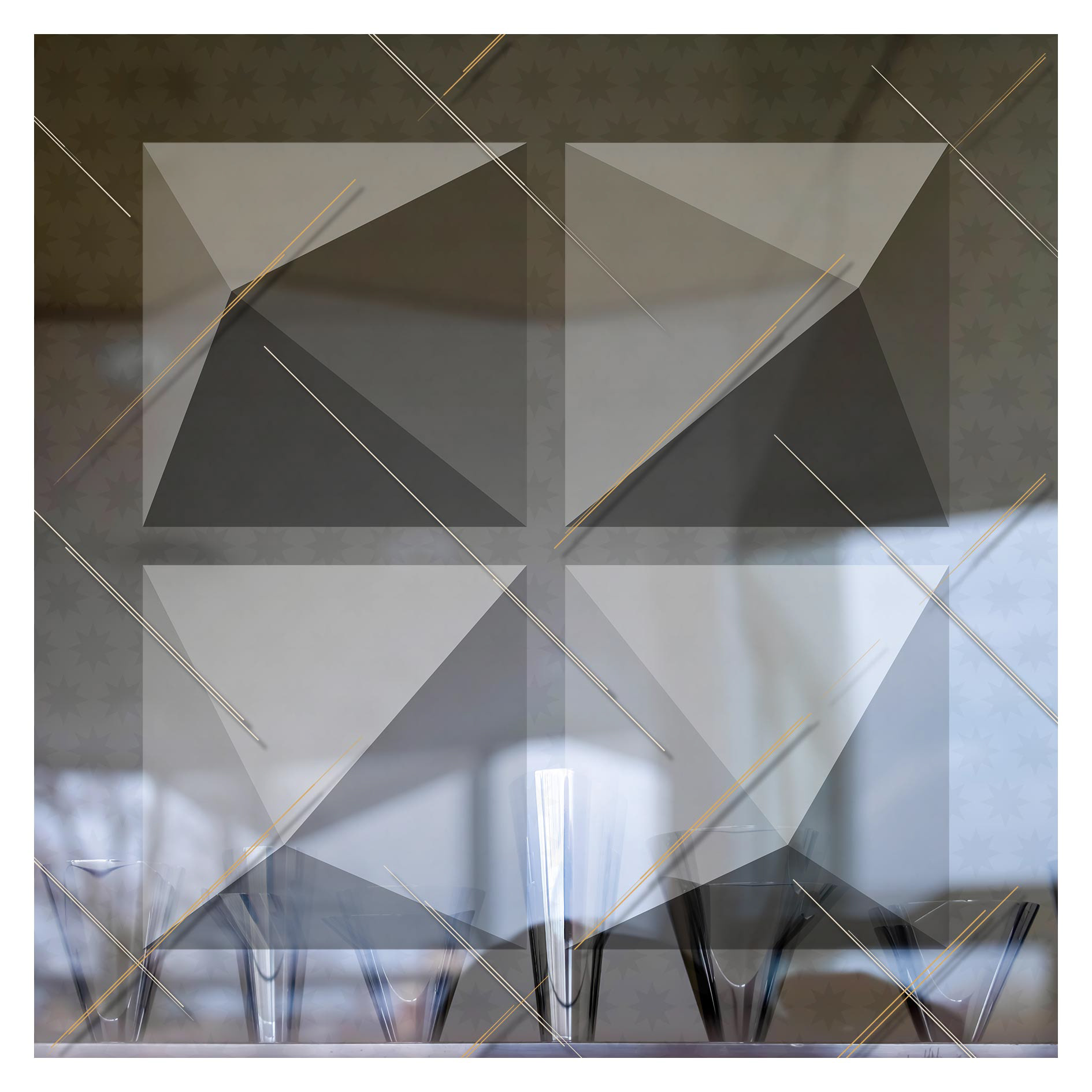
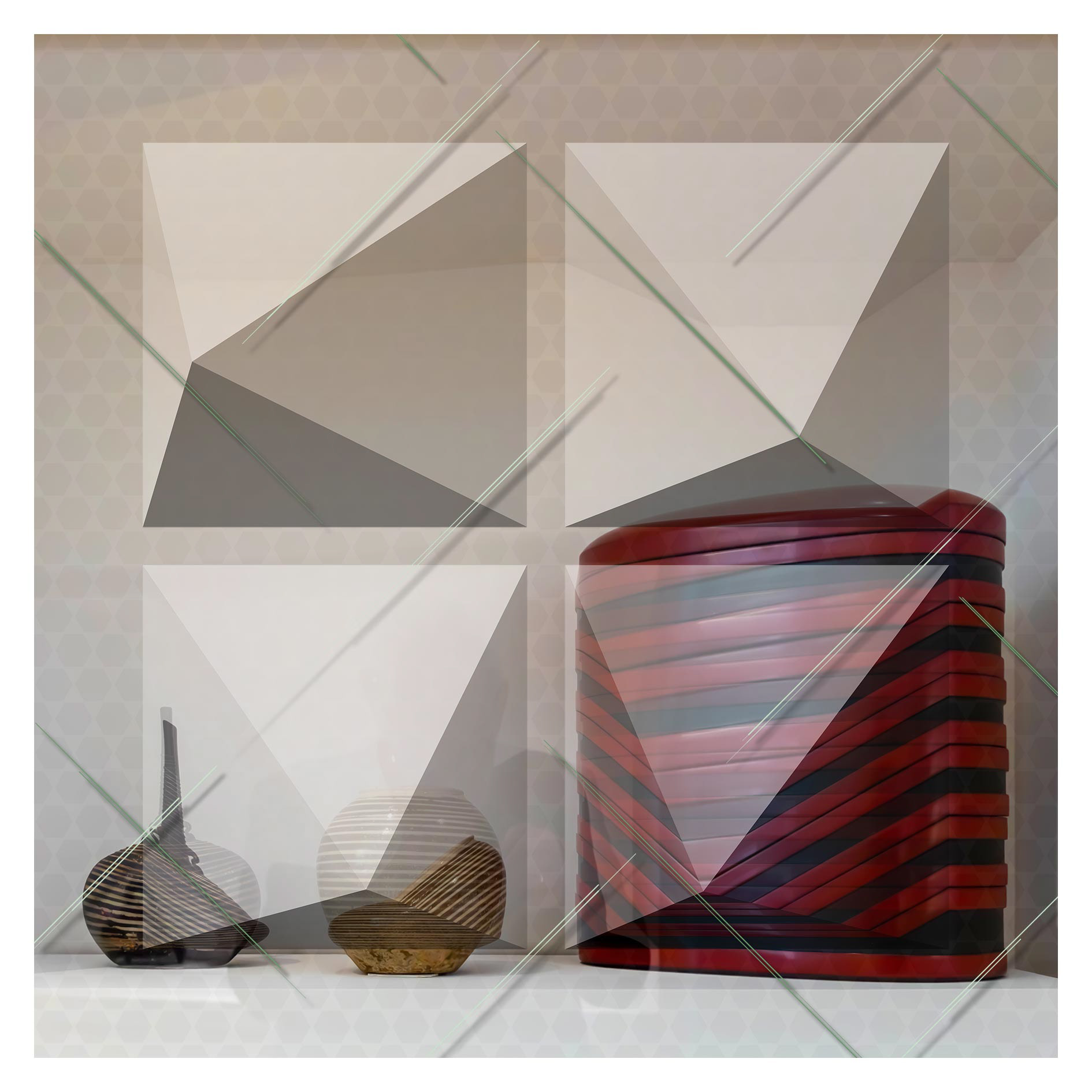
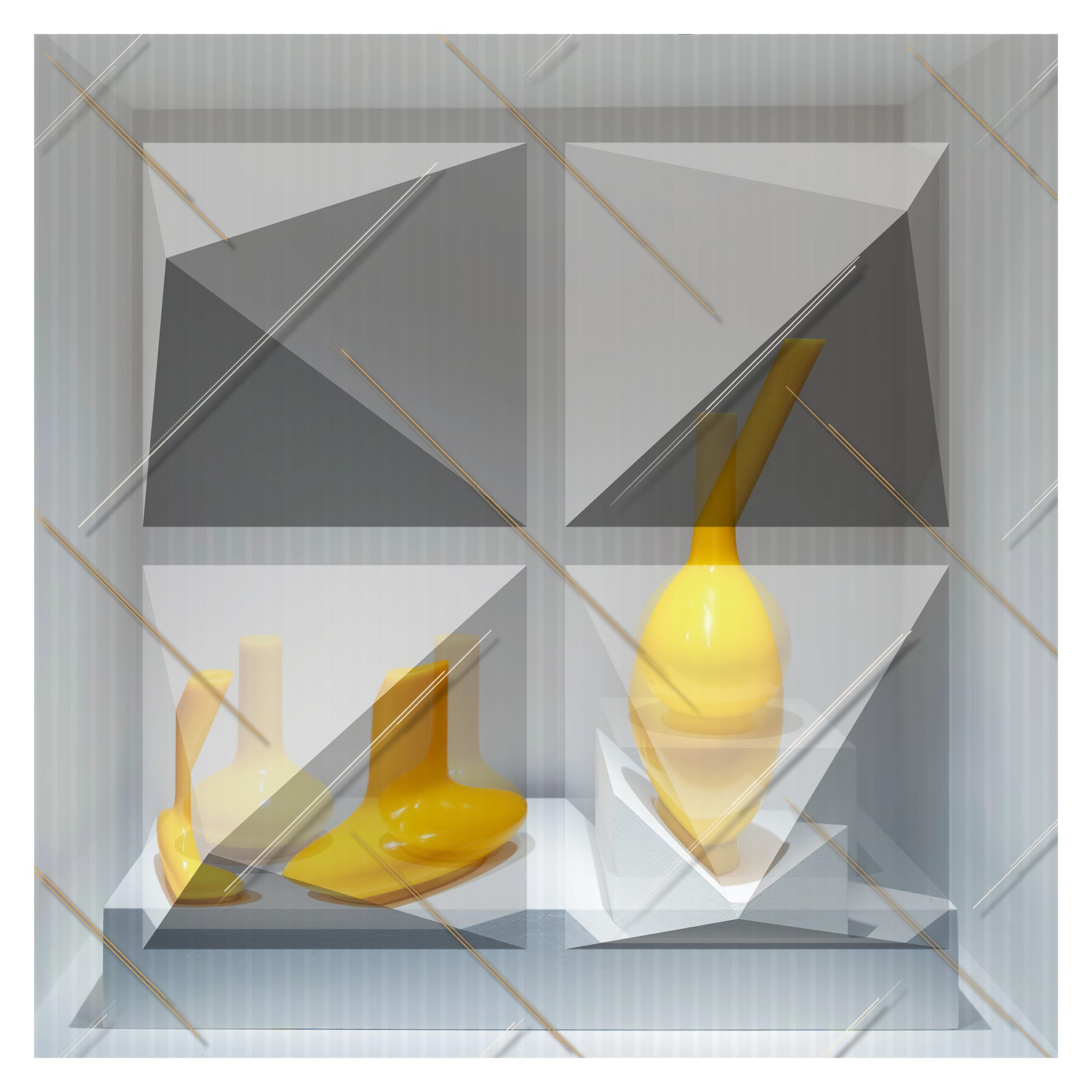
Conversation on the Calais-Dover ferry
"We are surrounded by constructions," says the artist as the chalk cliffs of Dover approach outside. In the Club Lounge of a ferry, three travellers – a composer, an artist and a film director – talk about images, sounds, stories and the need for meaning. It is a tentative, otten exchange about the mechanisms of our perception: How much do narratives shape our understanding of the world? And what could art look like that eludes this urge to interpret?
What begins as breakfast turns into an insightful debate: about empty spaces in art, about the power of stories and about the difficulty of enduring the incomprehensible. The composer describes her music as a form of resistance to linear dramaturgy – sounds that stand still, that refuse to be heard. The director defends storytelling as a way of creating connections – but not at any price. And the artist asks: "What if what is served up is not the essential thing at all – but what remains unspoken?"
The photographic material in this chapter was collected in three exhibition centres: the Museum für Angewandte Kunst Frankfurt, the Fondation Maeght in Saint-Paul-de-Vence and the Musée cantonal des Beaux-Arts in Lausanne. Four simulated glass pyramids were digitally placed over these photographic interiors – precisely positioned and regularly arranged. These transparent forms break the perspective, reflect light and distort the motif.
The images defy unambiguity – just as the dialogue provides no conclusive answers. Instead, a space of ambivalence emerges: tentative, contradictory, open.
Chapter Two: With the foot in the wrong beat, stirred
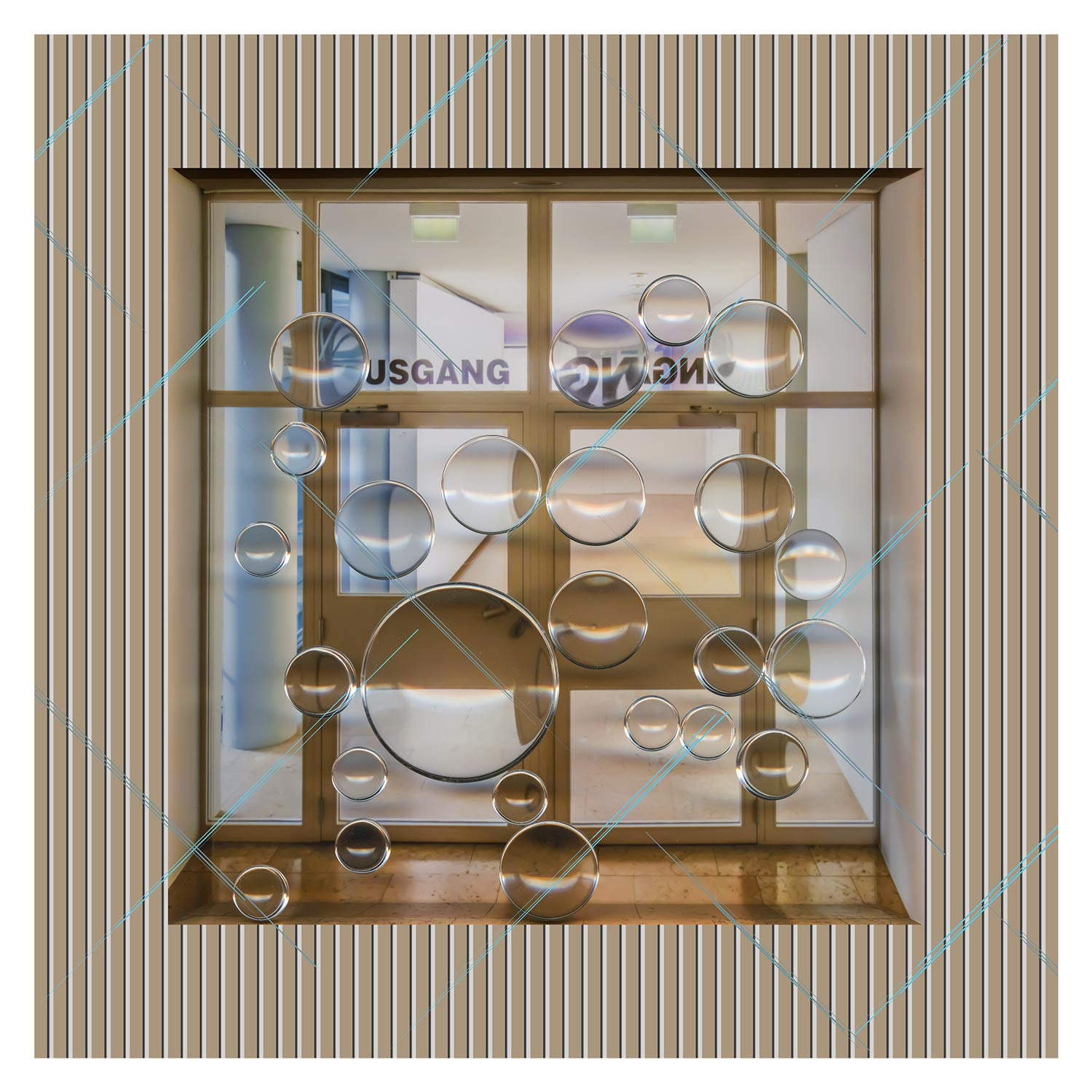
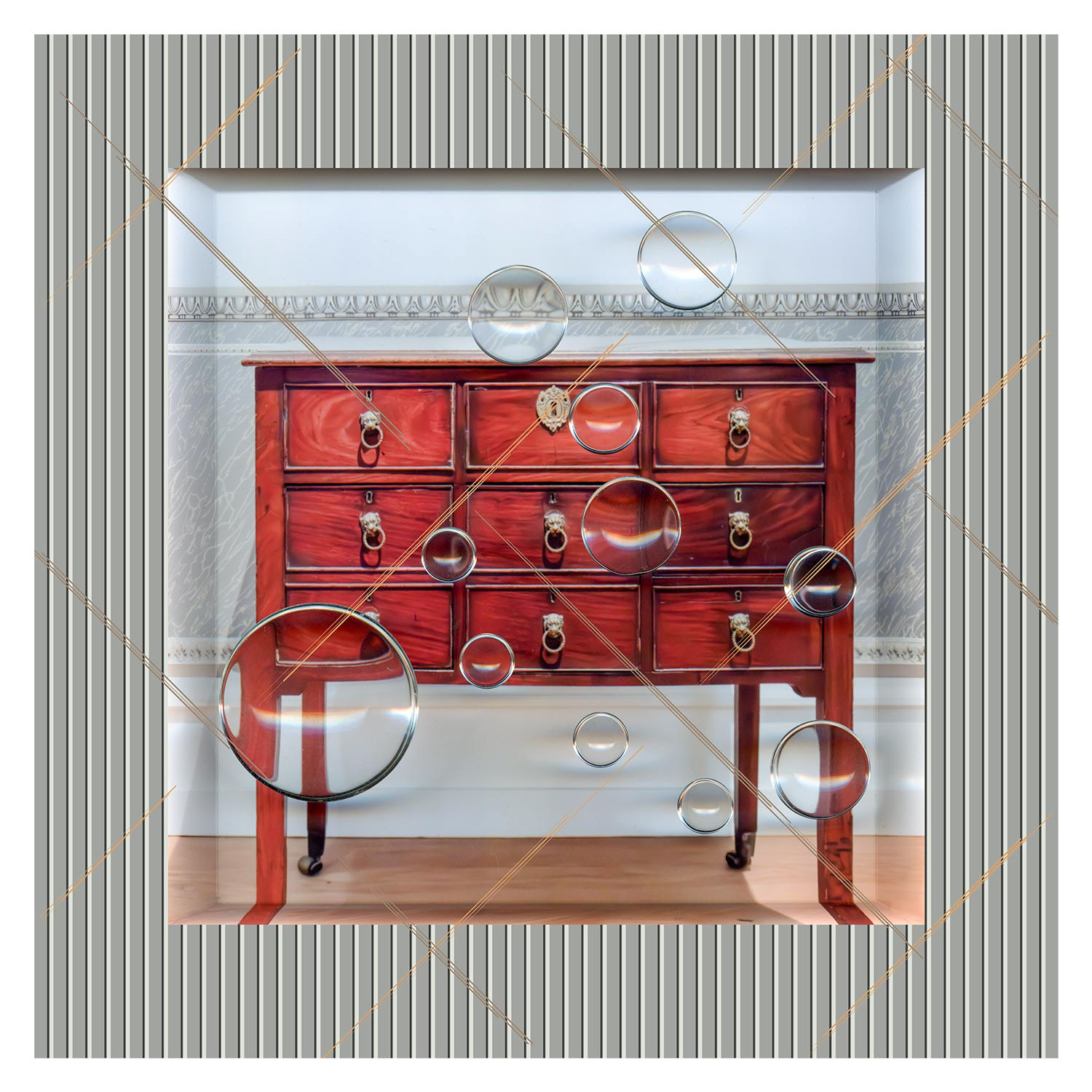
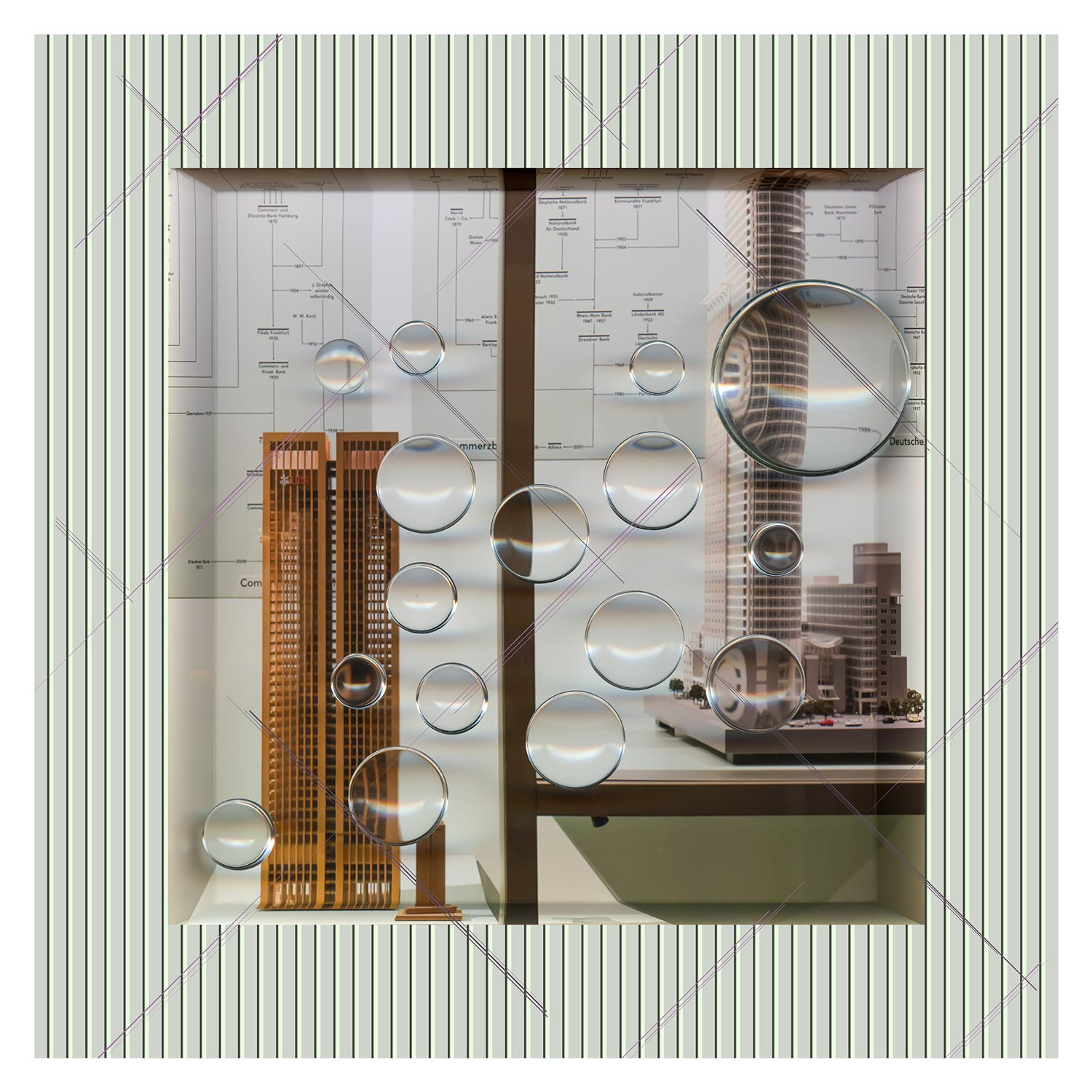
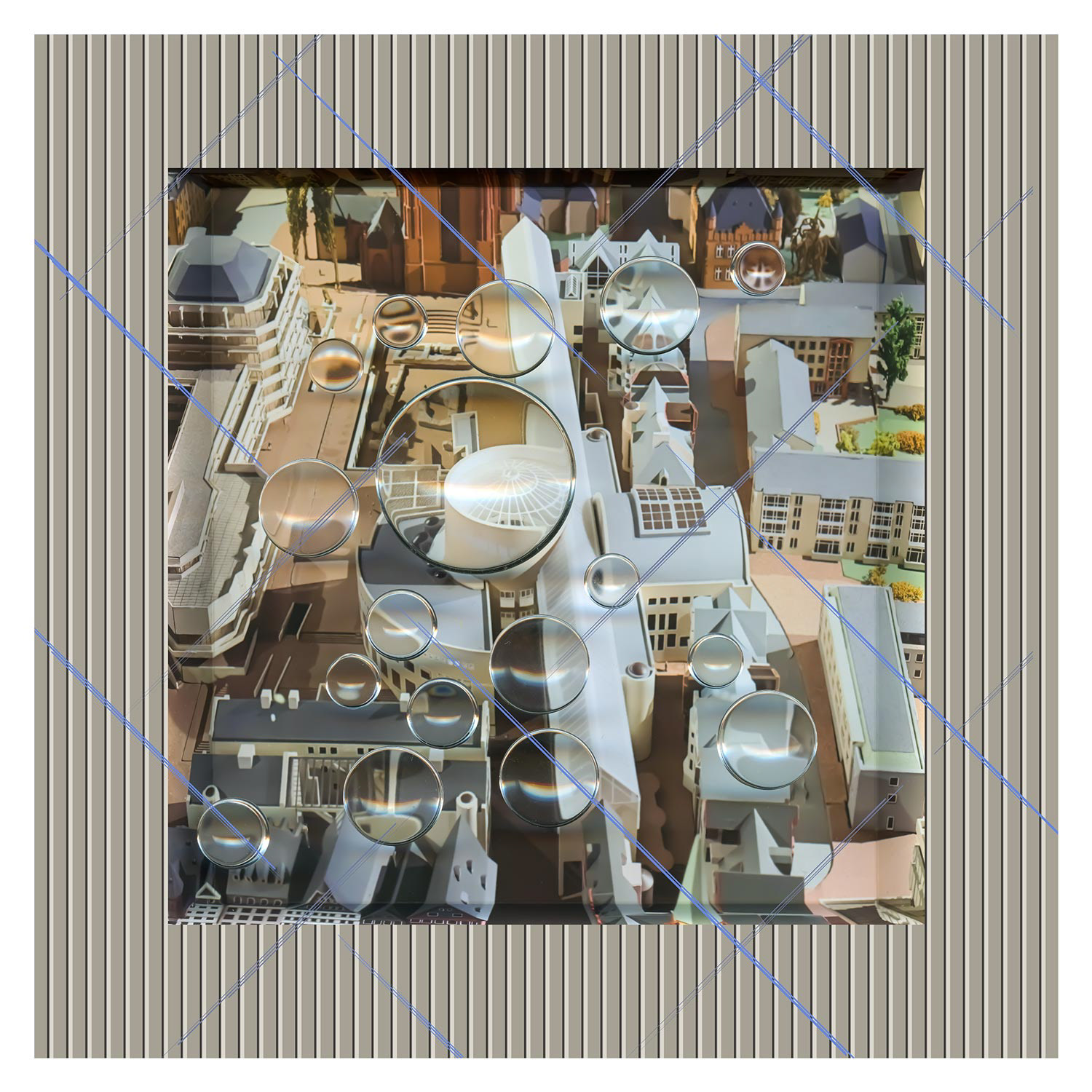
Conversation at Leeds Castle, Kent (UK)
The starting point for the visual works in this chapter are photographic images from the Museum Angewandte Kunst Frankfurt, the Historisches Museum Frankfurt and the area surrounding the Portikus. The images were printed on paper, folded into flat tubs, covered with round glass lenses and photographed again. These inlays create both optical refractions and spatial instabilities. In digital processing, the compositions are placed in a grid of stripes that suggests depth without actually reproducing it. The lenses act like magnifying glasses – or like disturbances.
What is depicted appears penetrated, displaced, simultaneously haptic and remote. The accompanying conversation also revolves around displacement – albeit in the area of artistic practice: the three protagonists visit Leeds Castle and discuss the pitfalls of interdisciplinary art between the moat, landscaped garden and castle library. Is the omnipresent hybridisation an ossification – or merely a staging? What still separates music, film and the visual arts – and what is lost when everything is interwoven?
While ducks make their tracks through the reflective lake, the three of them formulate a quiet criticism of curated complexity, pleasing dilettantism and the belief that relevance can be forced through a variety of formats.
"Perhaps," says the composer, "we need more courage to be disciplined again. Not for delimitation, but for depth." And the artist adds: "What is the in-between worth if the poles are no longer strong?"
This chapter thus also becomes a reflection on friction, on aesthetic decisions and on the juxtaposition of diversity. Not as a synthesis – but as a conscious, stirred coexistence.
Chapter Three: with shallow breathing, exhausted
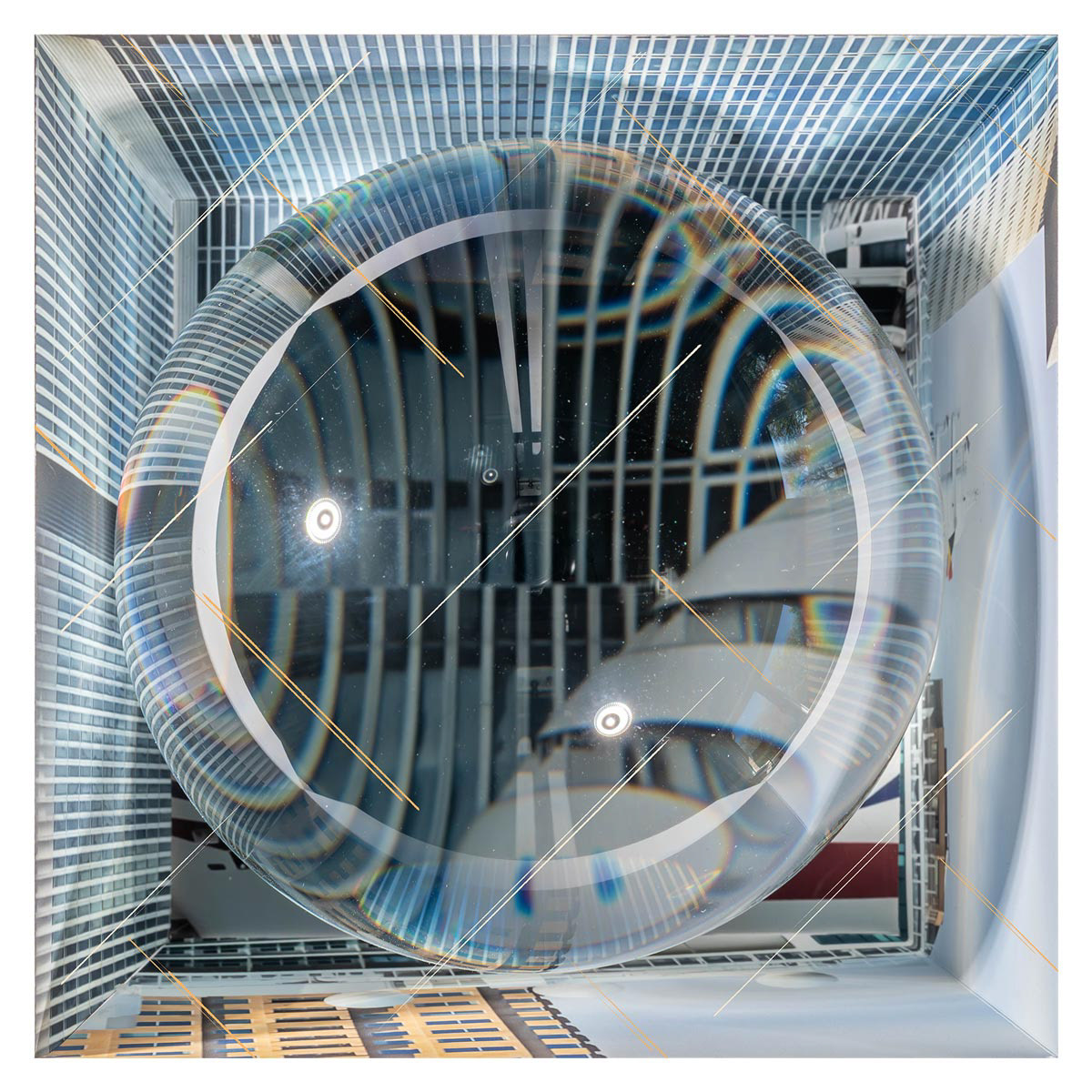
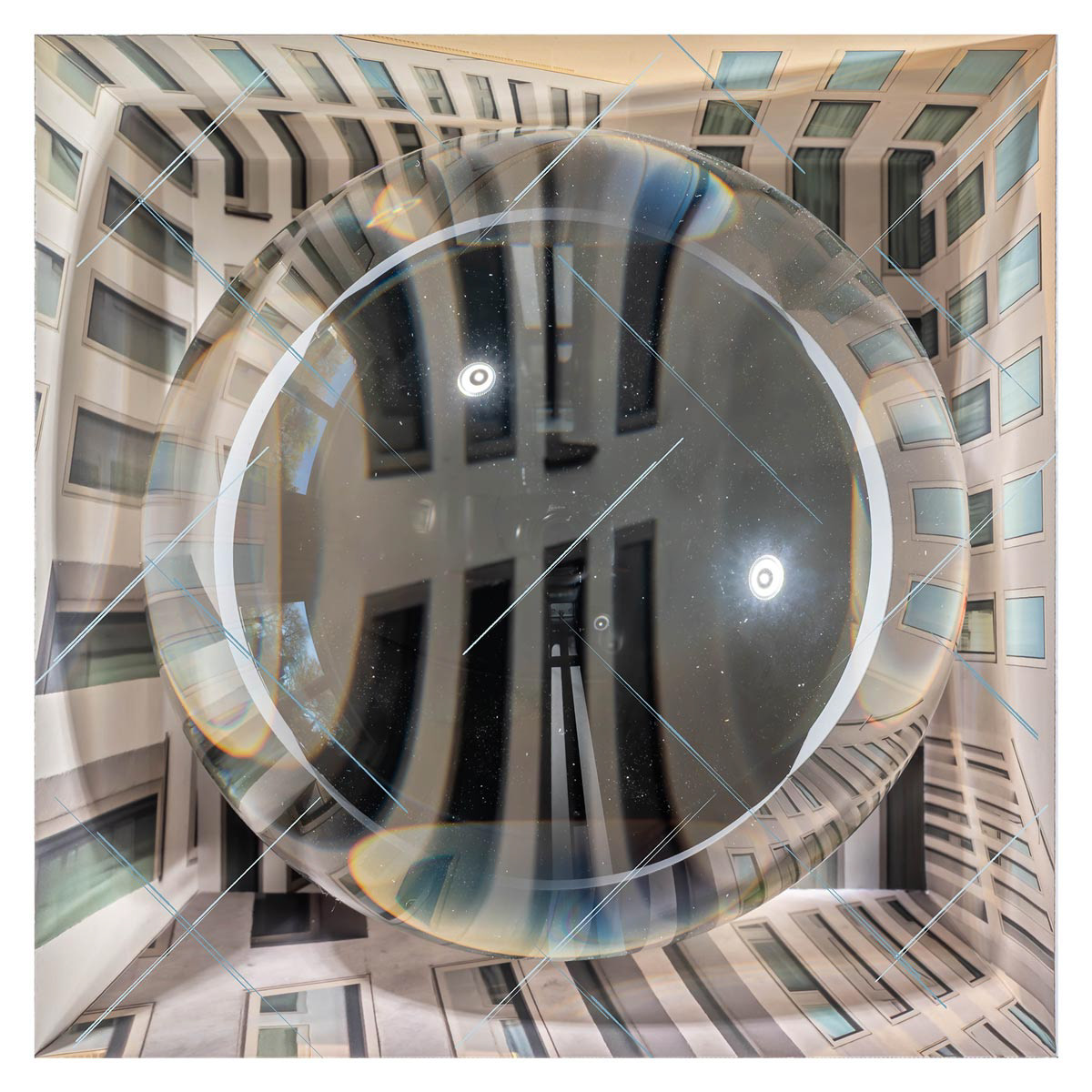
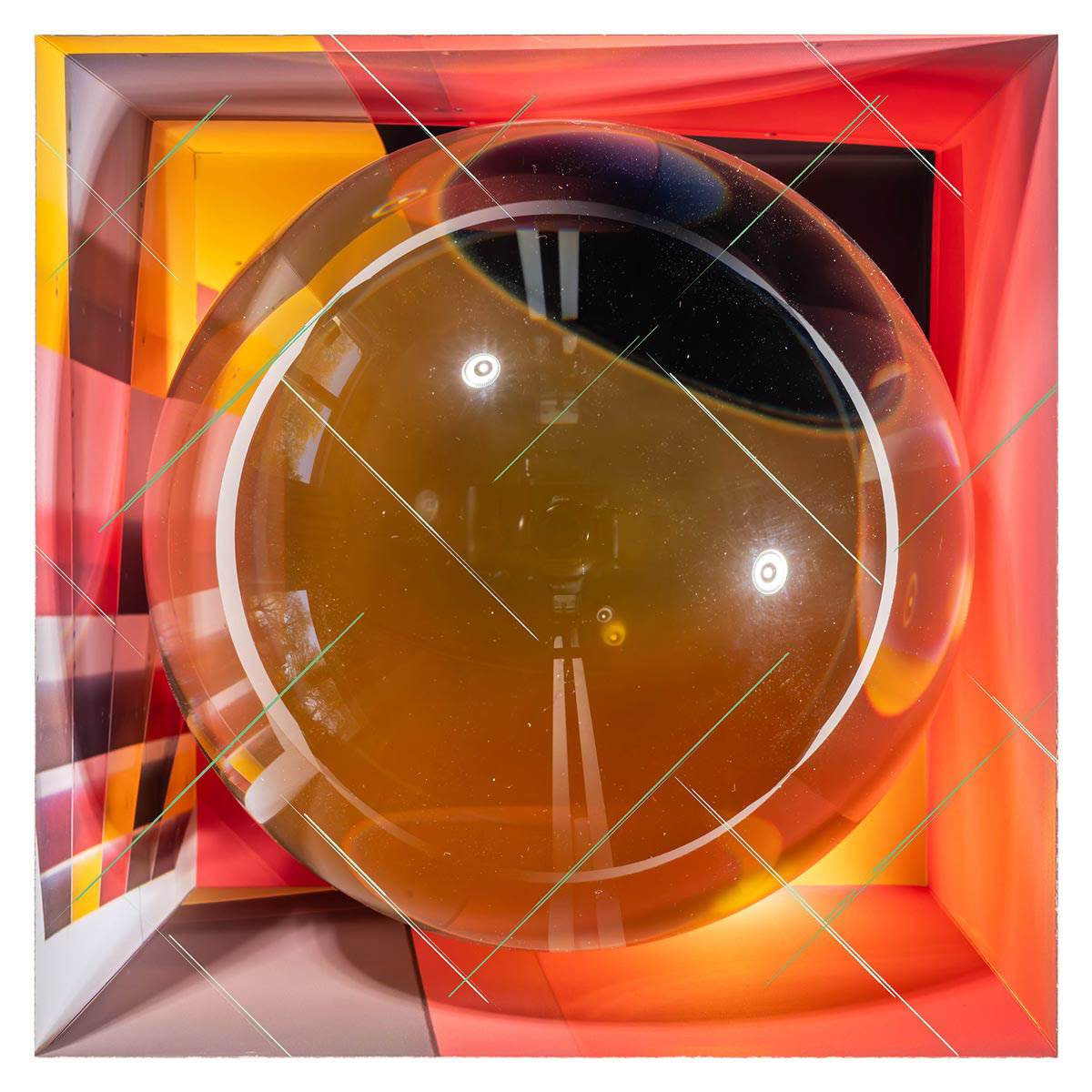
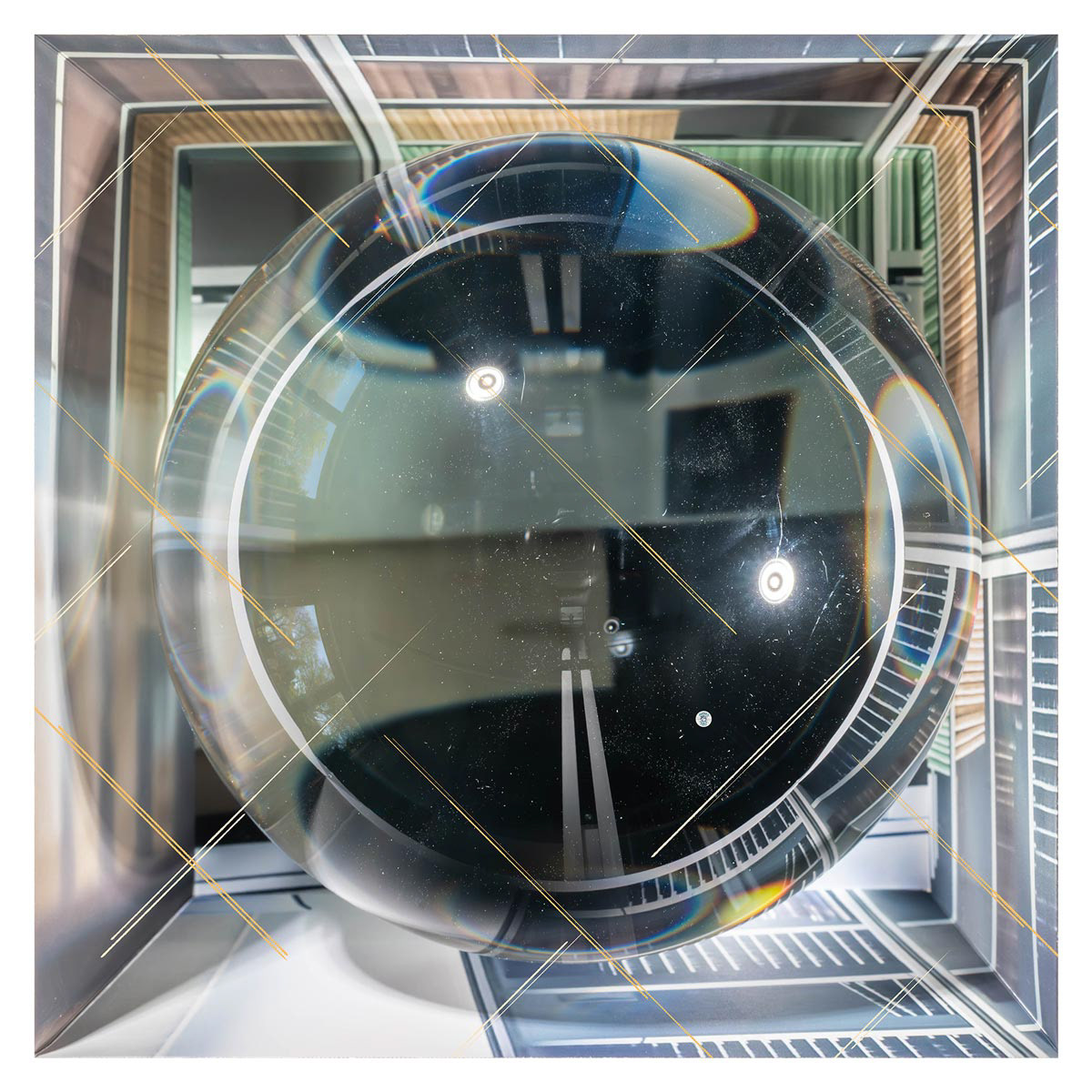
Conversation in Bath, England
The visual works in this chapter are based on photographic material collected at the Holland Amerikakade in Rotterdam, around the Humboldt Forum in Berlin, in Het Depot of the Museum Boijmans Van Beuningen and in the Neue Nationalgalerie Berlin. The images were printed on paper, folded into cubic boxes and filled with a solid crystal glass sphere (Ø13cm). Photographed from above, the sphere not only reflects and distorts the inside of the picture, but also reflects the space behind the camera.
This creates pictorial spaces between clear structure and visual irritation. The accompanying dialogue also revolves around visibility and reflection. The three protagonists – artist, composer, director – visit Bath in southern England: the Georgian square The Circus, the Roman Baths and the modern Bath Spa. Between representation, museum transformation and commercialised body care, a dialogue about image, ritual, perception and media mediation emerges.
The artist asks how one can shadow images that not only stage but also unsettle. The composer speaks of the sound of breath and resonance spaces. The director questions whether visibility is still a form of truth today – or whether it has long been a construction.
The glass sphere in the pictorial objects becomes a symbol: it not only reflects the motif, but also throws the gaze back onto seeing itself. "Perhaps," says the director, "a picture never just shows – it also conceals." "And perhaps," adds the composer, "it always means itself."
The chapter thus becomes a reflection on depth and surface, on authority, doubt and the fragile relationship between image and reality.
Chapter Four: with the tongue half swallowed, evaporated
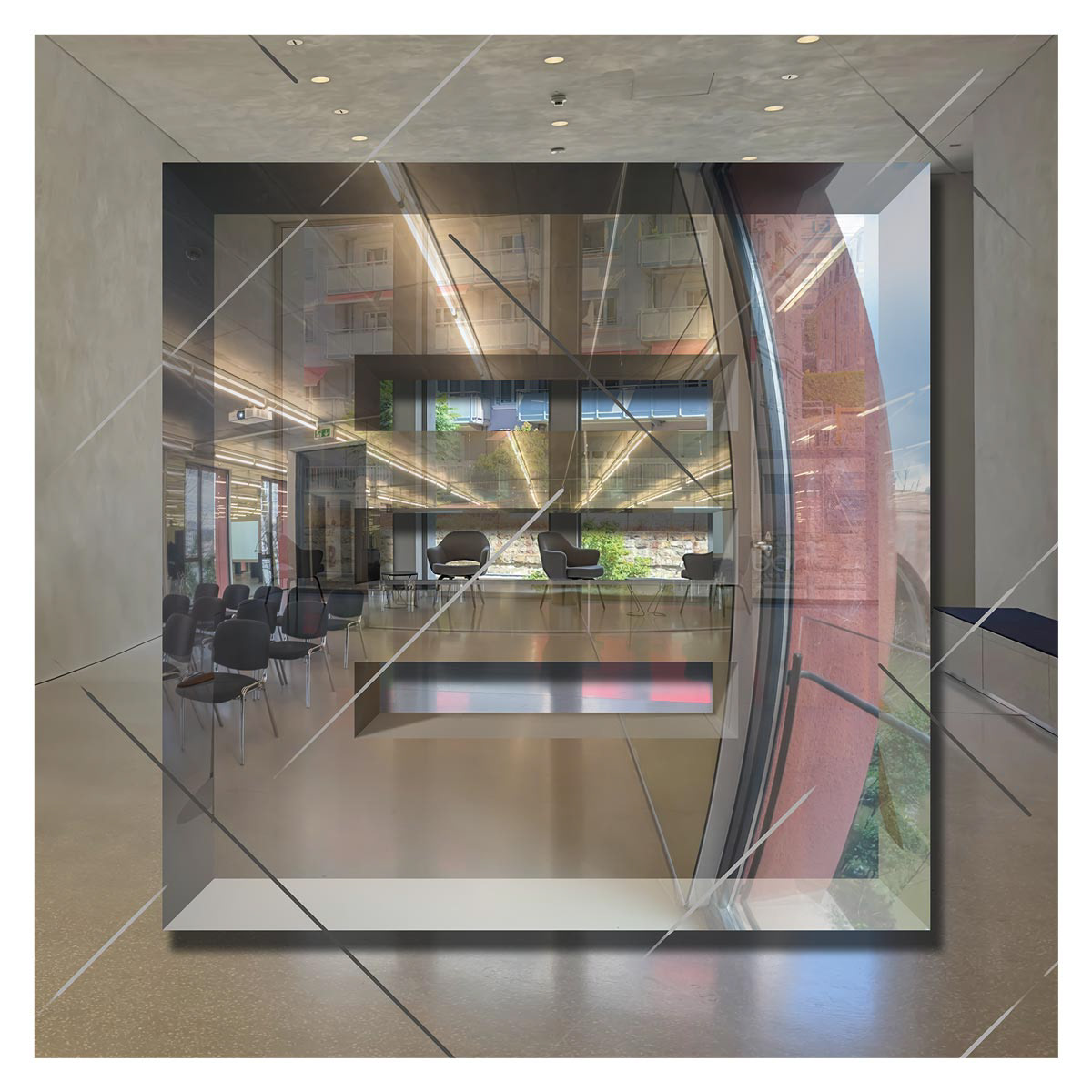
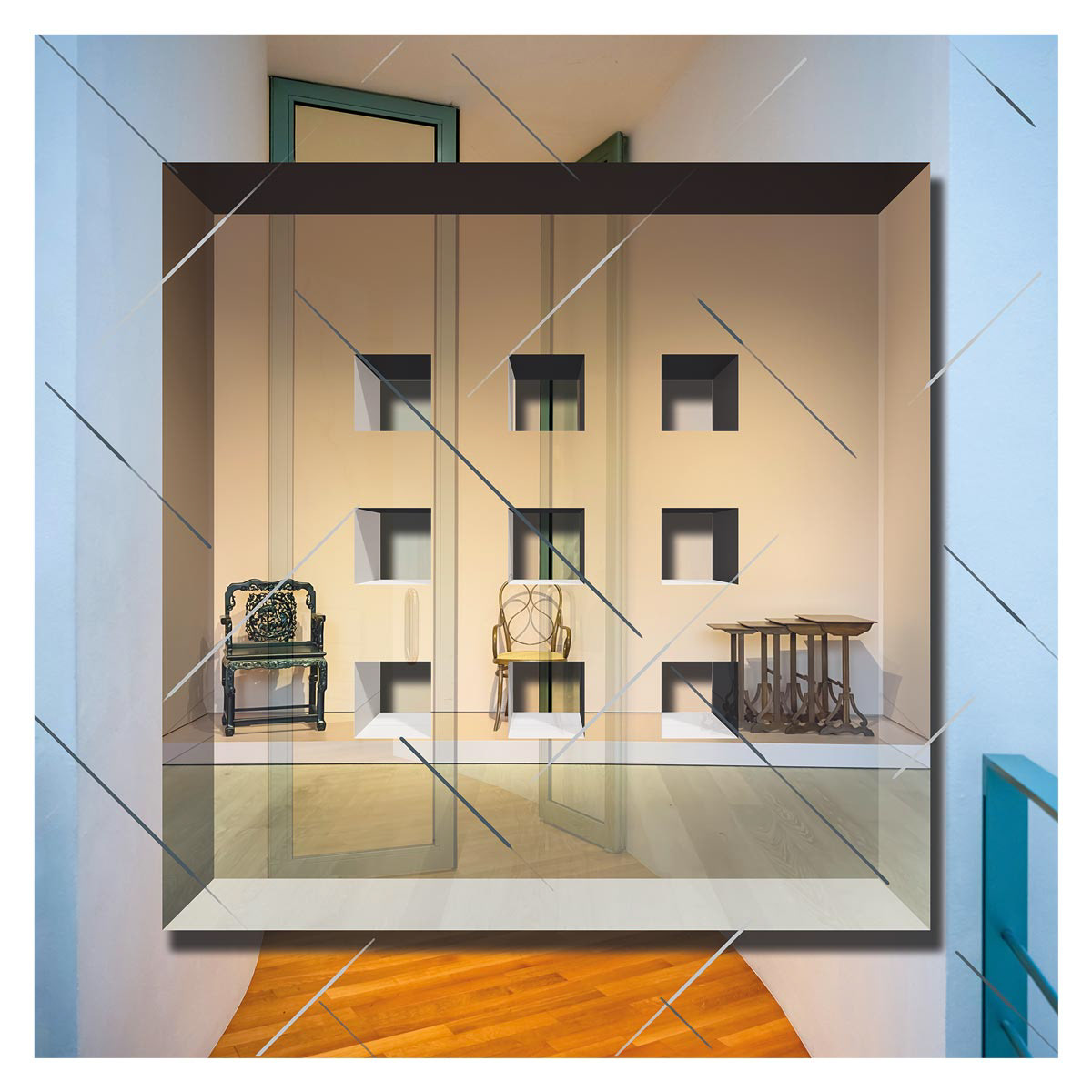
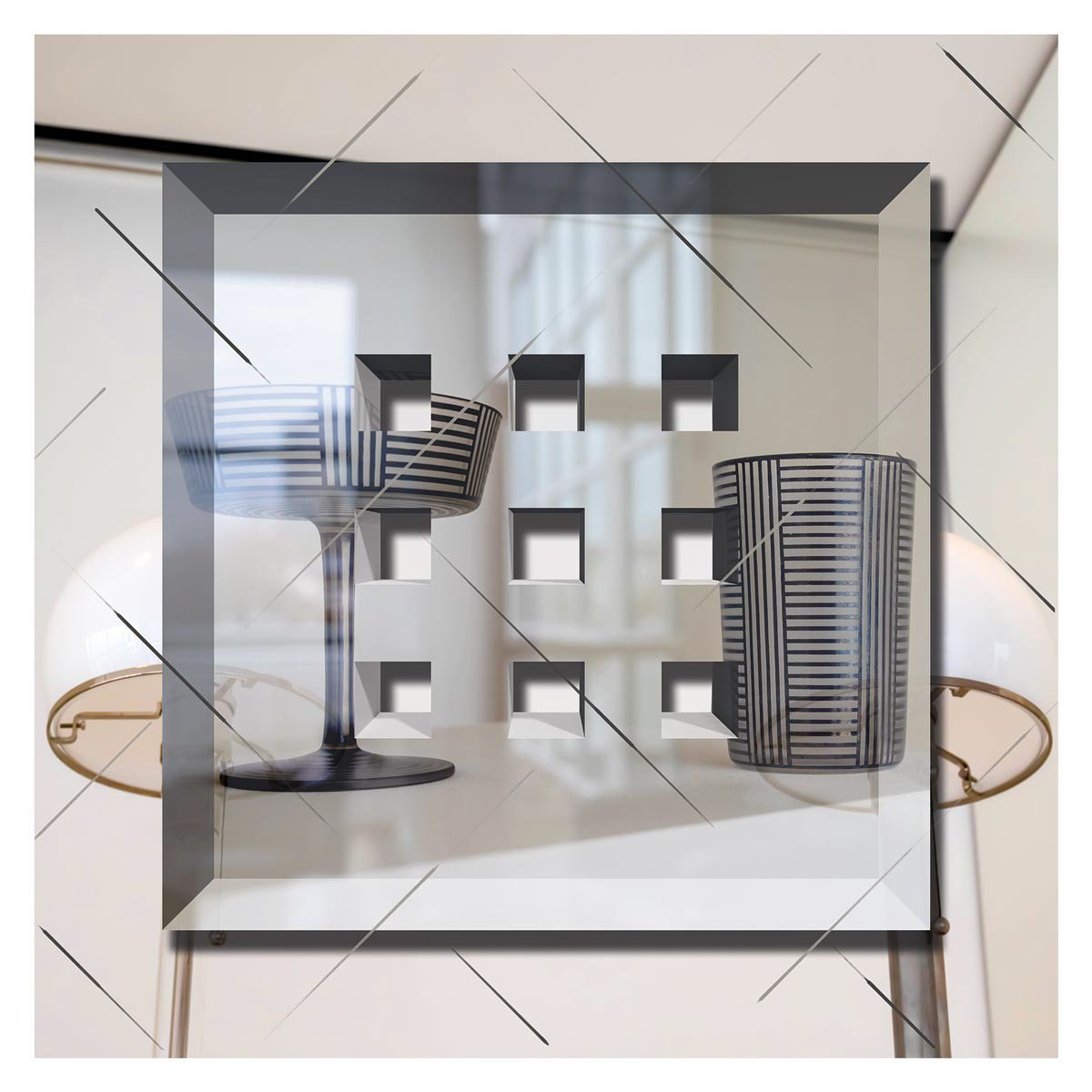
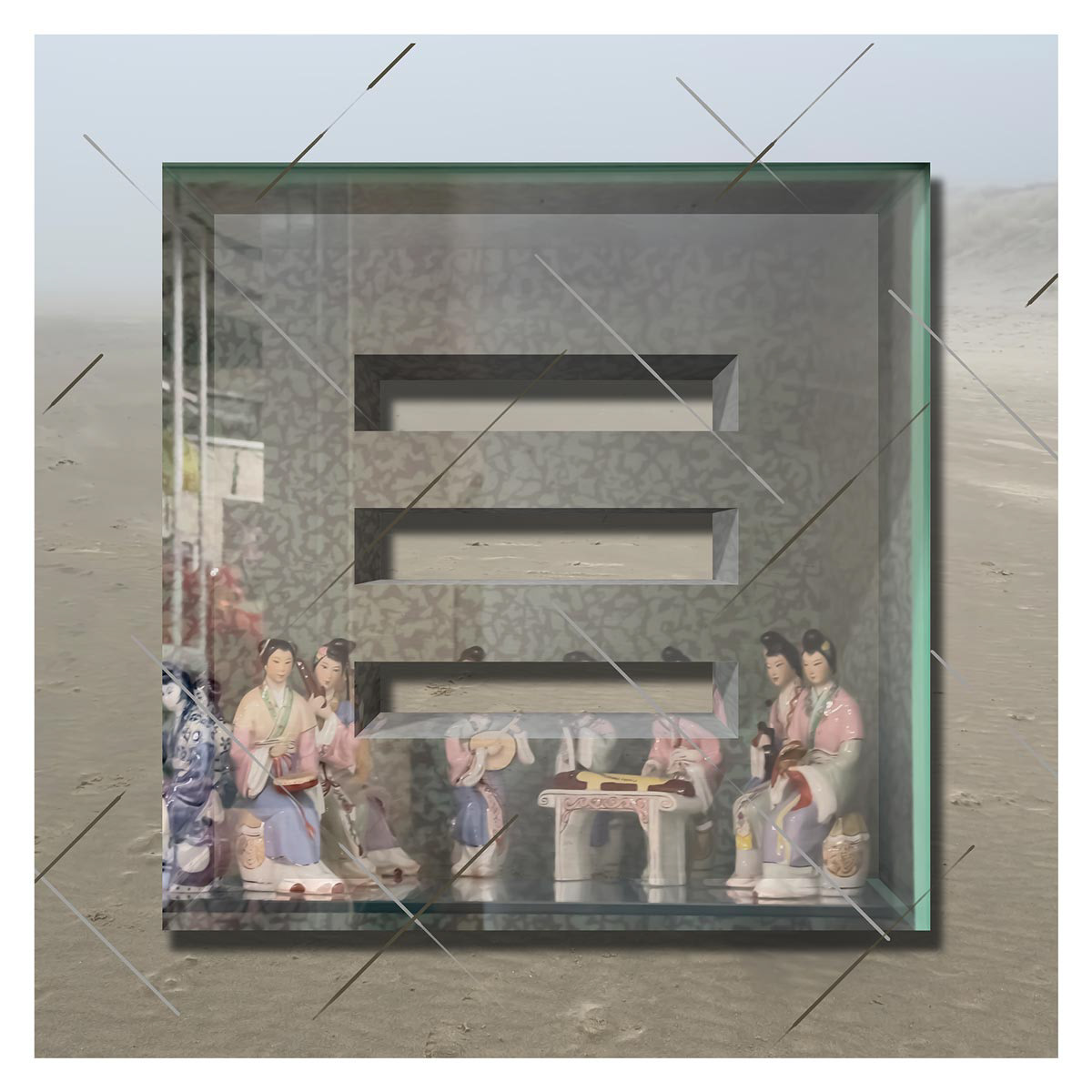
Conversation at Dartmoor, Merrivale (UK)
The pictorial works in this chapter are based on digitally processed photographs from European museums – supplemented by motifs from the Dutch North Sea beach, the artist's studio and the Wallrafplatz broadcasting centre in Cologne. A square, glass-like form is superimposed over each basic image, simultaneously providing insight and concealing it. It suggests transparency – and disturbs it at the same time.
In the accompanying conversation, the three protagonists meet on Dartmoor: a remote inn, fog, ponies, windy expanses. Inside: Fireside and thinking about perception. What does concentration mean in a time of permanent sensory overload? What happens when art leaves its traditional locations – and appears between a spa, supermarket or quarry?
"Vaporised," says the director, "does not mean condensed today, but simplified." The composer describes hybrid concert spaces, barrier-free but often empty of content. The artist laments the loss of frame and concentration. Together, they ask whether new venues really do oesthetise something – or merely generate curatorial effects.
The digital picture object with its floating glass structure reflects these questions: it shows what it withdraws. And withdraws what it shows. "Perhaps," says the director, "it is not the work that is condensed – but our attention." The artist nods. "We don't need new spaces. But a different way of seeing."
Chapter Five: with the neck slightly twisted, tricked
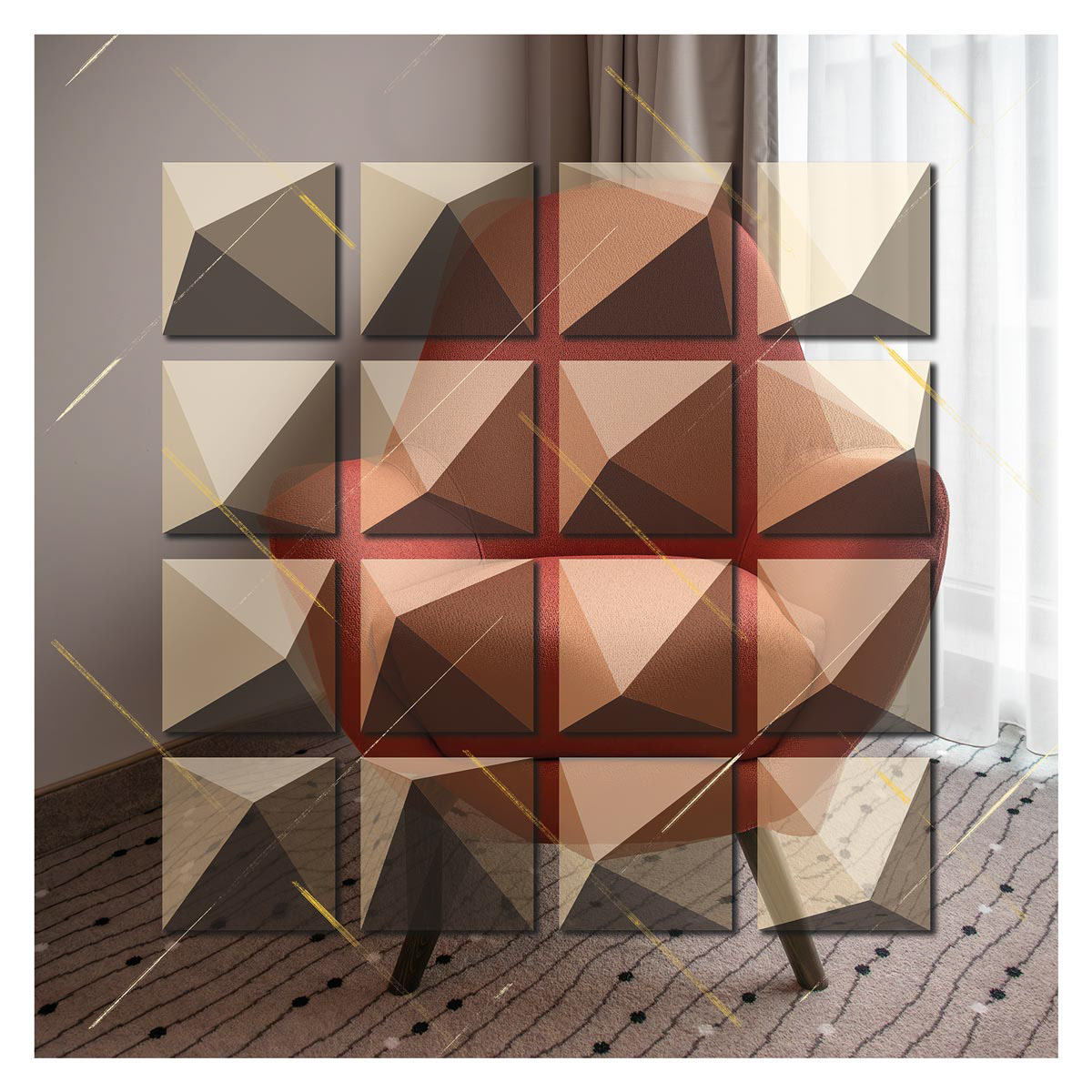
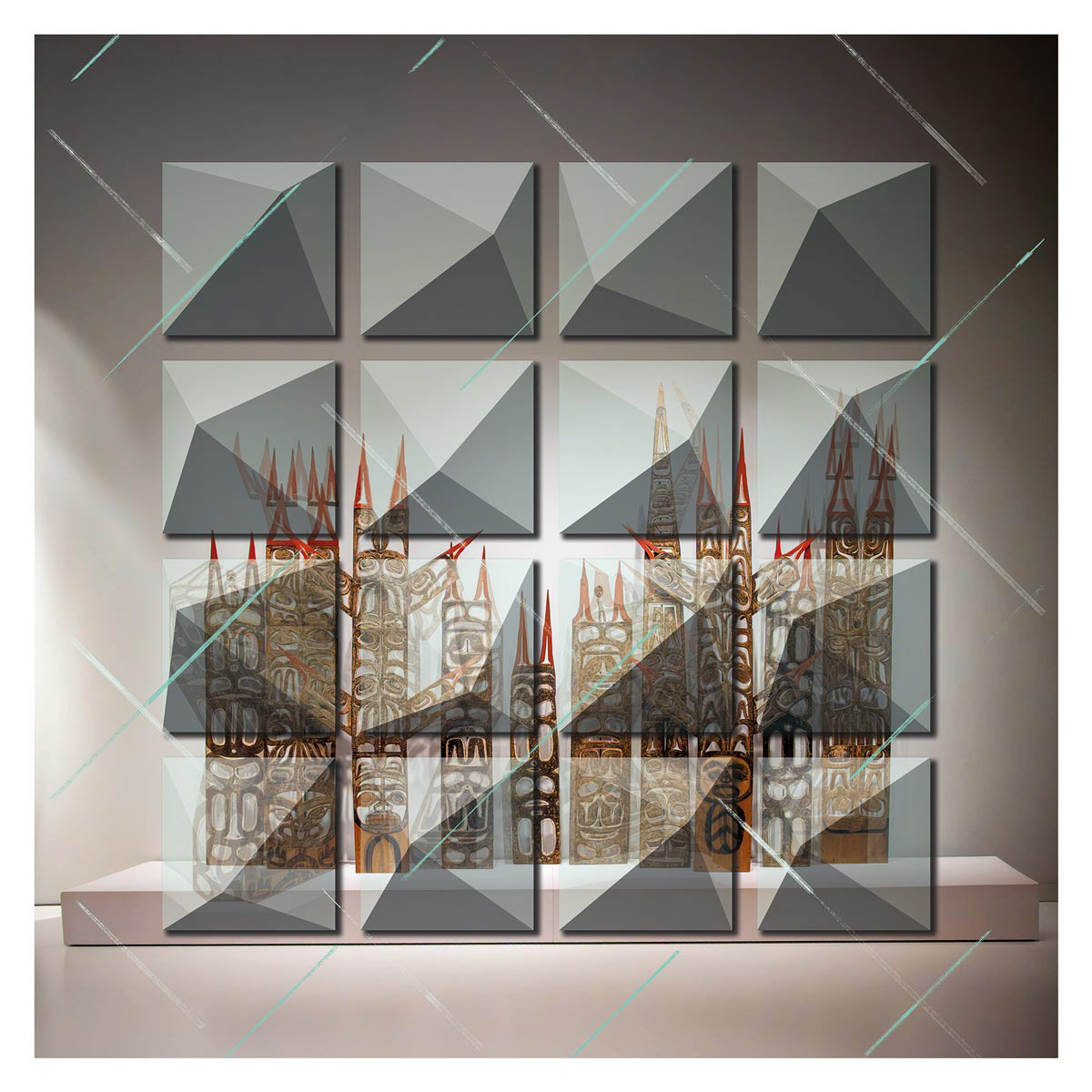
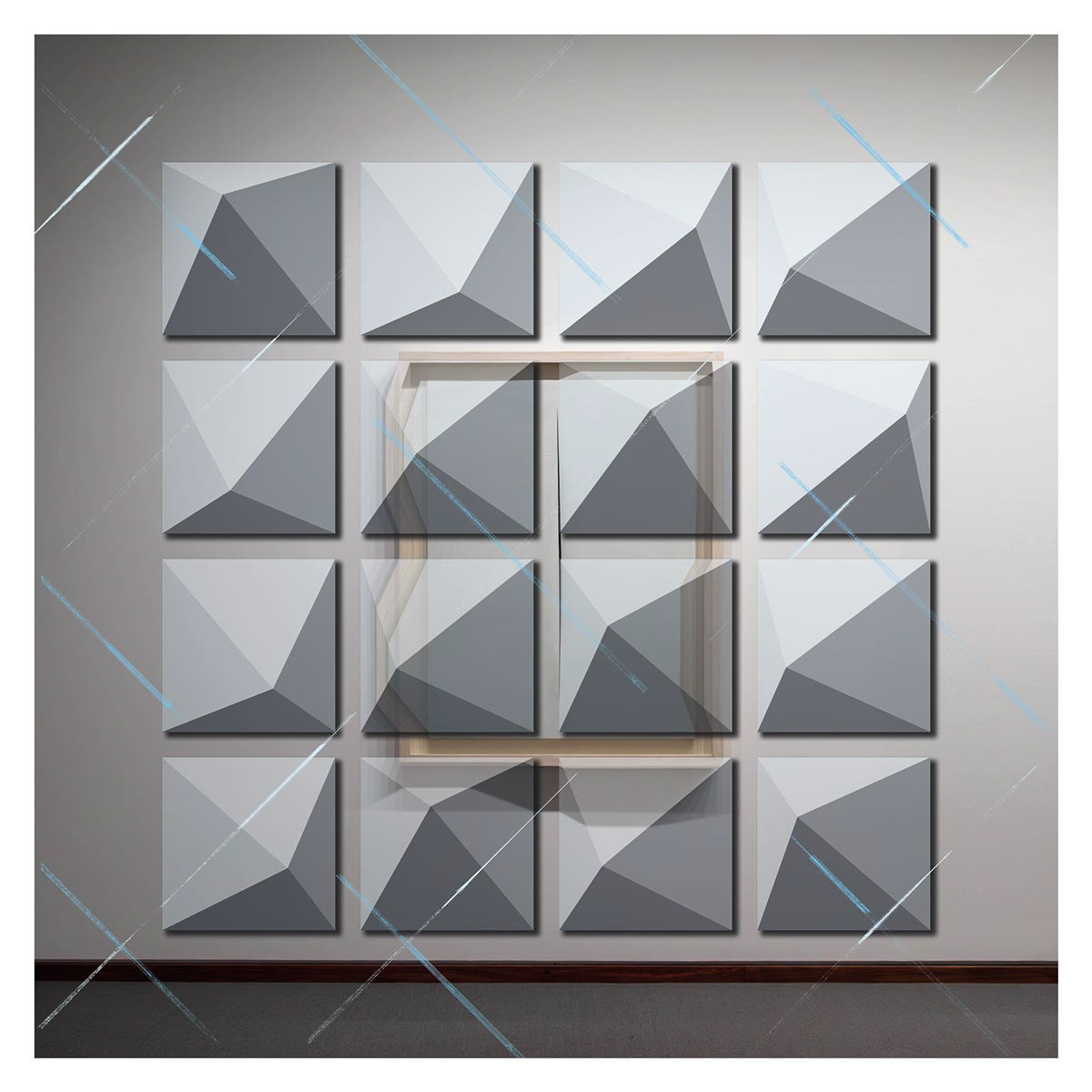
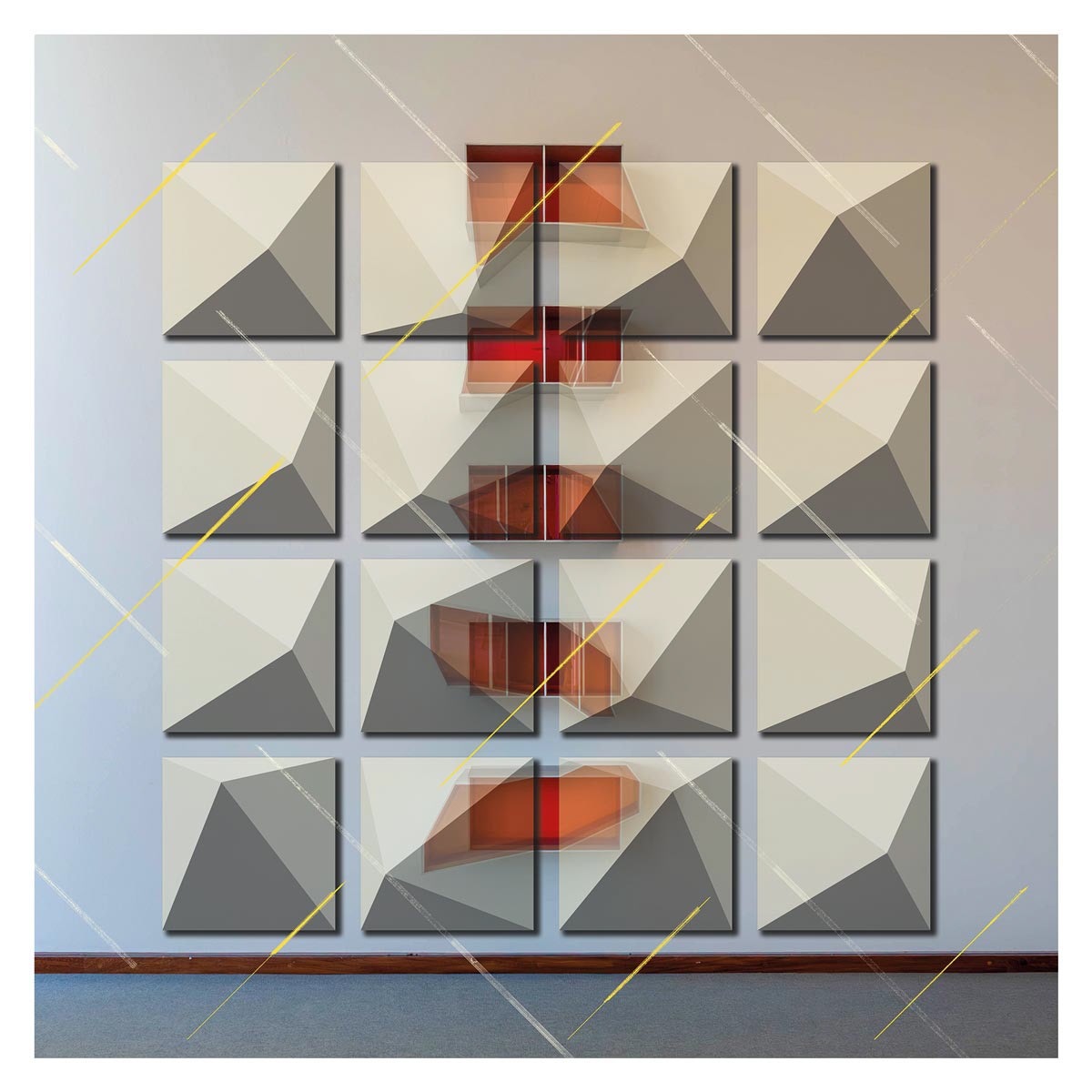
Conversation in Penzance (UK) and St Ives (UK)
The visual works in this chapter pick up on a motif from Chapter One: digital simulations of glass pyramids that are superimposed, distorted and reflected on the picture surfaces. But while there they break through the single image as a fourfold disruption, here they structure a precise square grid of 16 elements – serial, strict, geometric.
The glass pyramids conceal and reveal at the same time: what is shown appears broken; what seems hidden flickers through. The visual material comes from a hotel, the Humboldt Forum and the Neue Nationalgalerie – collected during a visit to the MärzMusik festival in Berlin in spring 2025.
The accompanying conversation is also about systems, rhythms and ruptures: the three protagonists travel to the Cornish coast – from the geometric Jubilee Pool in Penzance to the Tate St. Ives, where they drink tea with a view of the Atlantic. They talk about festivals as places of temporary concentration, about falling budgets and rising visitor numbers, about visibility and the loss of structure in art, music and film.
"Perhaps," says the director, "we have long been in a state of upheaval – but the glamour hides what is crumbling." The composer refers to dwindling funding, the shift to event formats and the logic of platforms. The artist would like to see the music festival as a ritual: as a space for attention, not just for attracting attention.
Between railway stations, biennials and sideshows, they discuss how relevance is created – and what stands in its way: measurability, formats, algorithms. "It's no longer about reach," says the composer, "but about resonance." And the director adds: "It's no longer about quantity – it's about memory."
The digital image structure reflects these questions: the glass pyramids are both intervention and order. What once began as a punctual irritation becomes a system here – precise but fragile. A surface that does not calm down. A grid that does not calm – but questions. Like the conversations themselves.